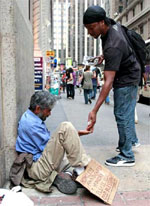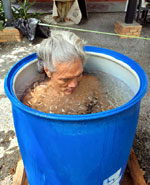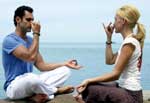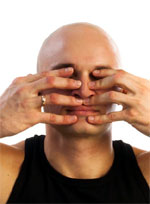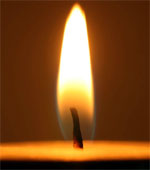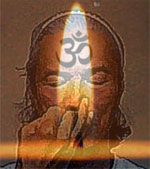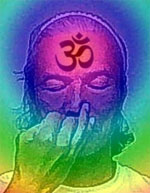8 Limbs of Yoga
8 Limbs of Yoga
What are they?
The practice of yoga has begun since time immemorial in India. But it was an oral tradition that was passed on from teacher to student. The sage Patangali, in an attempt to simplify yoga, codified the practice in what is now called the Yoga Sutras. In the sutras, he segmented yoga into 8 parts called the 8 Limbs of Yoga. The 8 limbs are supposed to be practiced in overlapping linear sequence - from moral grounding to ascencion.
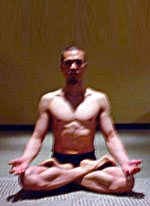 May 9, 2022
May 9, 2022
Asana (3): Eight Limbs of Yoga
Location ![]() : Chiang Mai, Thailand
: Chiang Mai, Thailand
Glossary of Terms
- abhyasa - constant practice or exercise
- adho - down or below e.g. Adho Mukha Svanasana - Downward Facing Dog
- adhyayanam - study, learning, reading e.g. especially of the vedas
- anga - part, limb e.g. Ashtanga, 8 limbs
- angula - breadth of one of your fingers e.g. so, the angula of one person is different from another
- ardha - half e.g. Ardha Baddha Padmottanasana - half-bound lotus forward bend
- Asana - Pose e.g. Ubhaya Padangusthasana
- Angusta - Big Toe e.g. Ubhaya Padangusthasana
- atma - true self, one that cannot be destroyed (same as citta? no beginning and no end?)
- baddha - bound e.g. Ardha Baddha Padmottanasana - half-bound lotus forward bend
- bhuja - arm or shoulder eg Bhuja Pidasana (Shoulder-Press)
- caitanya - good functioning, vitality, sensation
- citta - mind e.g. mind is not the thought. Citta is never born and never dies
- dakshina - right (side) e.g. doing the right side of an asana
- divya drishti - divine sight; divine understanding
- dosha - disturbance or disorder of the three humours of the body e.g. kapha, vatta, pitha
- ekagrata - one-pointed focus e.g. ekagrata citta, 1-pointed focus of the mind
- eka pada - one leg e.g. Tiryanga Mukha Eka Pada Paschimottanasana (oblique one-legged forward bend pose)
- gnanam - knowledge or understanding derived from meditation on higher truth
- granthi - combination, meeting place hmmm...I thought this meant 'knot' or obstruction in the passage of prana
- guna - quality or attribute
- hasta - hand e.g. Hasta Mudra (Hand Mudra)
- indriyas - senses. There are 11 - 5 of expression or action (karma), 5 of cognition (gnana) and the mind
- jadam - senseless; insentient; has no cognitive ability
- jagrata avastha - waking state
- jathara agni - the digestive fire of the stomach
- jivatma - individual soul enshrined in a human body, in contrast to 'paramatma', the universal spirit
- kapha - phlegm — one of the three humors of the body
- konasana - angled pose, like if the legs are far apart e.g. Upavistha Konasana
- krama - proceeding step by step according to a regular order or custom eg if I make my own sequence, like Wim Hof Maha Vedha, then it's a krama
- kriya - activity
- kumbhaka - retention of breath, either inside or outside the body
- mantra - sacred hymn or prayer; a sacred text
- mozham - distance between elbow and tip of finger
- mudra - symbolic gesture; seal (of a part of the body)
- mukha - face. e.g. Urdhva Mukha Svanasana - Upward Facing Dog
- nadi - energy channel, a etheric tubular vessel of the body, conduit
- nidra - sleep, eg yoga nidra or yogic sleep where the body goes to sleep but the mind remains awake
- nyasa - the assignment of various parts of the body to various deities through the use of prayer and gesture
- Pada - Foot e.g. Ubhaya Padangusthasana
- padangusthasana - big toe pose e.g. Supta Padangusthasana
- paramatma - supreme spirit or Brahman, in contrast to 'jivatma' which is the spirit enshrined in the human body
- parsva - side or side-flank e.g. Supta Pada Parsvagusthasana
- pitta - one of the humors of the body, its excess and vitiation
- pralaya - dissolution, death, destruction (of the world)
- prana vayu - breath, breath of life, vital air, subtle life force that gives life in the universe
- prapanca - universe, manifested world
- prasarita - spread out or wide-legged. This is often used to name a yoga pose, e.g. Prasarita Padottanasana (wide-legged standing forward bend)
- puraka - inhalation of the breath into the body, filling it up
- recaka - exhalation of the breath
- roga - disease
- sadhana - sustained effort leading to accomplishment; means of accomplishment eg yoga is my sadhana and abhyasa is practicing yoga
- sakti - power, energy, strength, eg Kundalini shakti
- sampurna - complete
- sanatana - dharma ancient eternal path
- sancharam - movement, travel, passage
- sastra - scripture, sacred book
- sattvaguna - the quality of goodness or purity
- shatkriya - purificatory processes
- siddhi - accomplishment; supernatural and marvelous powers (there are 8)
- sthiti - remaining stationary in a position or state
- supta - reclining or lying down e.g. Supta Padangusthasana
- tamas - quality of darkness, inertia, or ignorance
- tiryanga - oblique or sideways e.g. Tiryanga Mukha Eka Pada Paschimottanasana (oblique one-legged forward bend pose)
- Ubhaya - Both e.g. Ubhaya Padangusthasana
- upasana - formal meditation
- upavistha - seated e.g. Upavistha Konasana
- urdhva - upward e.g. Urdhva Mukha Svanasana - Upward Facing Dog
- utthita - extended or stretched e.g. Utthita Parsvakonasana (Extended Side Angle Pose)
- vama - left (side)
- vidya - knowledge, yoga vidya is knowledge in yoga
- vata wind - one of the three humors of the body, its excess and vitiation
- vayu - air; wind; vital air
- vidya - knowledge; science
- vinyasa - an arrangement or assemblage (of a sequence of asanas)
- vritti - movement or activity
What is Asana?
Asanas are the physical postures in yoga that develop body strength, balance, flexibility, endurance and optimization. The body radiates with divine luster. The practice removes excess fat and eliminates stubborn wastes without the aid of any surgical instrument. The Rishis regarded asana as operation without instruments. Asana cures diseases, increases memory power, mental ability and bring about spiritual realisation. Asana generates heat in the body and warms the blood. Warm blood collects toxins as it is distributed throughout the body. The toxins are then flushed out of the body. Asana enhances good blood circulation which unblocks nadis for efficient energy flow. Asana primes the body for the next limb, Pranayama. Back in the day, people in India cured all diseases using yoga asana and pranayama (in Hatha Yoga Pradipika, it states that asana/pranayama cures disease, makes you strong and gives long life. BUT bandha/mudra activates Siddhis and gives you power).
In SVETHASVARA UPANISHAD chapter II, the following is stated which I find true in my case due to my practice:
"He has no disease, does not become old, has no death (not really sure what they mean by this), never feels lazy, has uniform health throughout life, will never have bad desires (the revenge-desire is the hardest to deal with), his body will have a certain KANTHI (I looked it up, but can't find its meaning), will have powerful speech, there will be no odour in his perspirations and he will never have diabetes, dropsy (edema, retention of water leading to swelling) and diarrhea."
Yoga and Asana: A Misunderstanding
Perhaps Yoga is most misunderstood because of Asana. There is a general thinking that Yoga is Asana and vice-versa. There are many advanced yoga poses posted on social media and people think that perfecting that pose is yoga. In many yoga studios, the one-hour yoga consists only of asana and practitioners think that is all of yoga.
It is no wonder that people who practice this kind of yoga indeed become strong. But they also remain angry, rebel against a world they never made and unable to exorcise demons that have taken long-term residency in them. Why? Because the practice is not complete - asana is only one of 8 limbs.
How Many Asanas are there in Yoga?
There are many answers to this. In Patanjali's sutras, there is only one, and that is a seated post. Krishnamacharya claims that his teacher knew 7,000 asanas, from which he learned 700. He added that there were 84,000 at the time of Sri Sankaracarya, 64,000 at the time of Ramanuja and 24,000 at the time of Madhva. Through time, these asanas were lost in obscurity. Now, there are 84 acknowledged asanas. (note: For this reason, I am only listing down a limited number of asanas, mostly written by Krishnamacharya in his Yoga Makaranda book.)
Growing Your Own Yoga
I was once told by a yoga teacher that my yoga wasn't yoga because my asanas were 'not' yoga asanas. For anyone to make this ambitious claim, he/she must know all the 84,000 asanas in yoga...during Adi Sankaracharya's time). Furthermore, it is my personal conviction that once you become strong in your yoga practice in its traditional sense, you should now follow your intuition/excitement/Aha Moments, and venture out of the nest. Ultimately, you develop a kind of yoga that is unique to you given your body anatomy, your life experience, your genetic predisposition, etc. Your yoga becomes more authentic. Yoga is organic. You can grow your own yoga, but you must be well-grounded in its tradition first before venturing out.
Ideally, instead of 'venturing out', you should find a guru who can guide you at the higher levels. But realistically, this is very difficult. Where do you find a real guru? Even in India when I visited, instead of finding a guru, I ended up teaching Indian people how to do yoga - which I found ironic. They themselves don't know where to start to find this guru. Even Rishikesh, the fabled land of yogis and mystics, there are so many 'gurus' preying on lost souls.
Frustrated, I ended up reading established yoga books and doing my practice accordingly. These authors (most of them have long passed on), essentially became my gurus.
How are the Asanas Done?
Since asanas are essentially physical workouts, it should be dealt with like a gym workout on one hand (proper warming up, stretching, going all the way to the safety edge without going beyond, maintaining proper form, etc.)
On the other hand, asana is also yoga, so the other more essential elements should be there (synchronicity with breath, intention, mindfulness, visualization and gratitude).
Unless specified, head should default to Jalandhara bandha, drshti should default to Ajna chakra, first 3 fingers should default to holding a body part. In doing both sides of the body, do the right first. Inhalation should be as long as exhalation when doing asanas. Only nose breathing. Every asana will consist of 3 to 48 vinyasas. For thin people, kumbhaka should be done on the inhale (antara/puraka kumbhaka). For overweight people, breath-hold should be done on the exhale (bahya/rechaka kumbhaka). Always rest the body for about 15 minutes after practice to transition the body back into the default world, and also to close the open pores of the skin.
Not all asanas need to be practiced by yogis. Which asanas are practiced depends on age, peculiarities, and individual constitutions. In fact, there are some asanas not suitable for some people. In the absence of a guru, use your body intuition to discern if the asana you're doing is resonating or not.
An Ideal Asana Class
Krishnamacharya's asana classes are not limited to adjustment and proper form. He included such information as the benefits of an asana, recommendations for linking the breath to the asana, the vinyasa krama, contraindications, classical references and derivations from ancient sources (both well known and obscure), common variations, useful modifications and therapeutic applications, mental focus during the practice, suggestions for the practice of bandhas, etc.
Asana Primer
Before beginning the practice, take a moment and put the intention and focus in place - don't be mechanical with just movement. Establish heart, intention and focus before the practice. The book calls for chanting a sanskrit mantra - OM mantra would be a good start for beginners.
Never use force in 'perfecting' the asana. Stay within your safety edge. If you injure yourself because you pushed the asana too hard, it means you don't get it.
Sun Salutation (Surya Namaskar)
Tadasana
(Mountain Pose)
Method: (p150) Stand in Tadasana with arms raised vertically, open palms with thumbs lightly touching each other. Equal inhale to exhale. Hold this pose for 15 mins. Best to do this daily during sunrise.
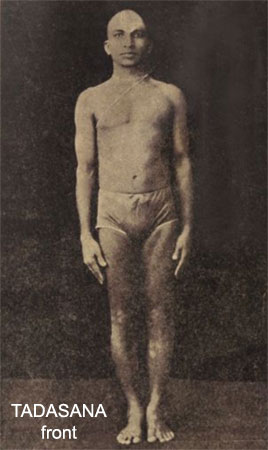
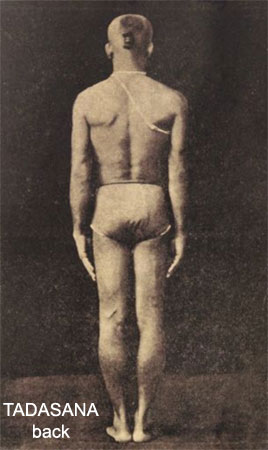
Variation: Standing up with arms up for 15 mins.
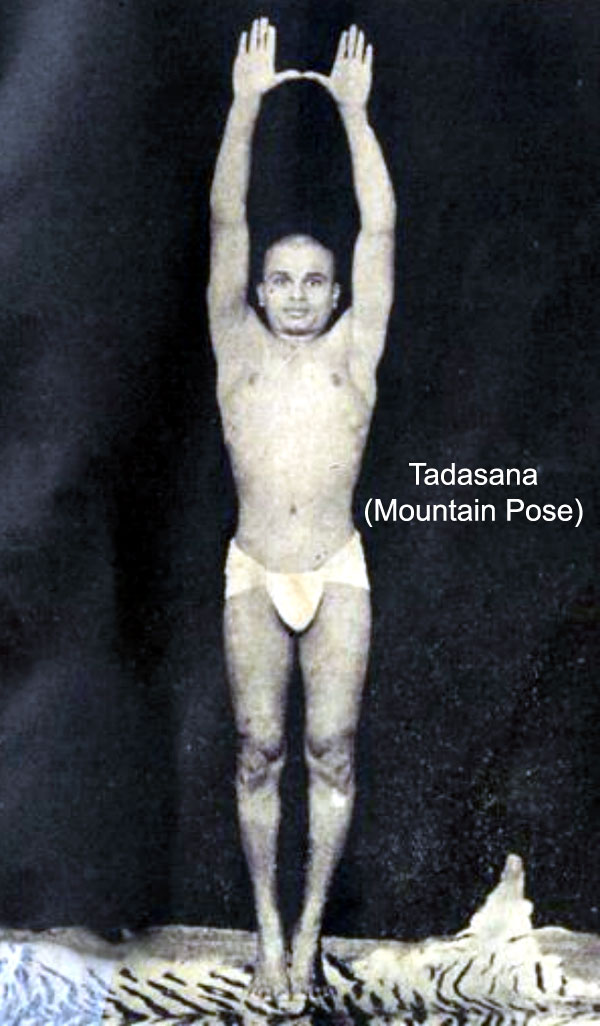
Benefits: This will activate energy and put a bounce on your stride. Digestion will also increase. Life span is increased.
Uttanasana
(Standing Forward Bend)
Method: (p59) On Tadasana (Mountain Pose, Samasthiti), inhale fully. On the exhale, bend forward with straight legs, arms reaching to the back of the legs or on the floor, head to the knee (Adhomukha Uttanasana). Empty the lungs. Hold and observe sensations. Inhale while lifting the head up with straight back and gaze on the nose tip (Uttanasana Sthiti). Hold and keep awareness. Exhale as you bend forward again, head to the knee. Repeat this cycle many times. For beginners, tremors might be felt in the arms and legs - this is normal. Always keep the knees straight.
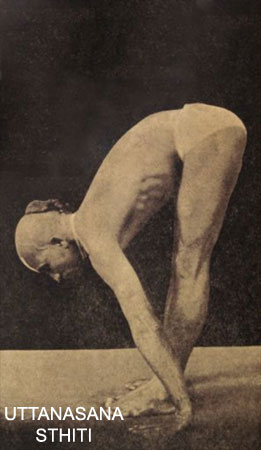
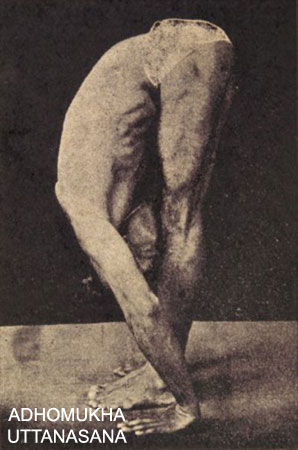
Padahastasana is a variation of Uttanasana - hands facing up underneath the feet or fingers on the big toes.
Benefits: Uttanasana removes all diseases in the lower abdomen and optimizes the digestive processes.
Chaturanga Dandasana
(4-Limbed Staff Pose)
Method: (p73) Inhale on Tadasana. Exhale on the forward bend (Uttanasana). Inhale half-way looking up (tips of the fingers on the mat, back straight, head looking forward). Exhale, step back and assume a high plank (ideally, you should jump back, but I noticed this is injury-prone since at times, you will land on your toes and not on the ball of the feet). The body should be ruler-flat. Make sure the elbows point to the back. Breathe. Exhale, lower the body as you bend your elbow towards the back (not to the sides), while keeping the body straight. Stop before body touches the mat - only the hands and feet touch the mat.
Variation: The hands can either be by the chest or by the waist (more difficult). If by the chest, the toes should be tucked-in. If hands are by the waist, the top of the feet touch the mat.
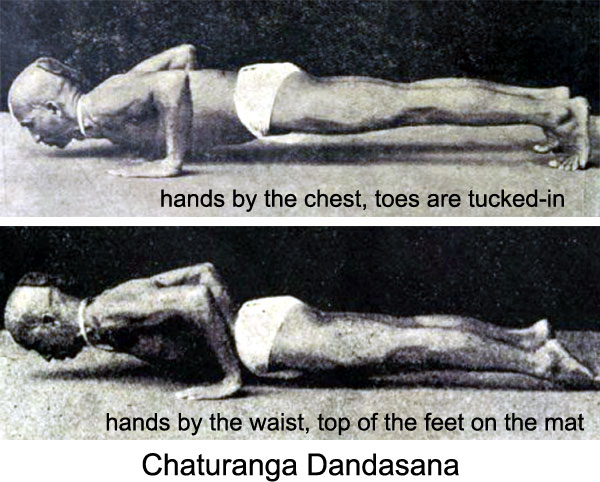
Benefits: Improves core, pecs and triceps. Primes the body for arm-balancing (like handstands)
Urdhva Mukha Svanasana
(Upward-facing Dog)
Method: (p73) From Chaturanga, inhale fully and simply lift the body up while the hip and legs remain where they are. Arms are now straight. The back will arch - this is a backbend. Lift the sternum and open the chest, even pulling the shoulders back. The hands should be aligned with the navel at this point. Keep the head upright (not tilting back) and Drshti (gaze) on the tip of the nose. Hold this inhale as long as you can (Antara kumbhaka).
Variation: In most yoga studios, from Chaturanga, the body is moved forward and lifts up into Upward Dog. I used to do this for many years, but I personally find it injurious on the deltoids (shoulder muscles).
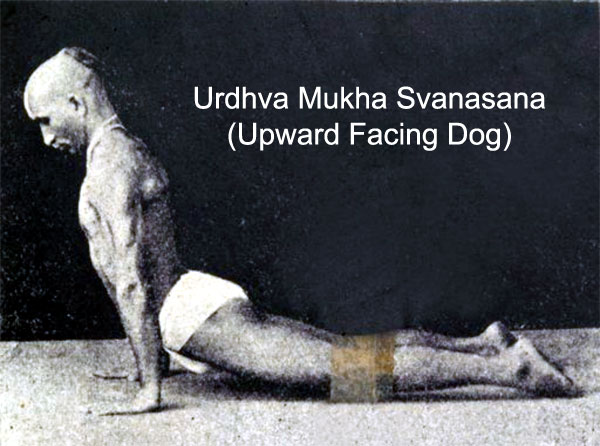
This just came to mind. Instead of holding the Upward Dog making as many breaths as possible, I could also hold on the full inhale (like what the book says), exhale on the Downward Dog (without holding, since the object here is to hold on the Upward Dog) and inhale and hold again into another Upward Dog. I can keep doing this until satiated. Sometimes I wonder about doing just one kriya for an hour. Like doing just this. By the end, I guess you become a master in Upward Dog and Downward Dog.
Benefits: The natural slouching of the body will be addressed. Samana Vayu is activated enhancing digestion. The Apana Vayu is activated promoting elimination.
Adho Mukha Svanasana
(Downward-facing Dog)
Method: (p77) From Chaturanga, inhale and revert into a High Plank, exhale and lift the pelvis up and push it back with legs and arms straight. You should look like an inverted "V". Still holding the exhale, perform Maha Bandha Mudra (chin to the chest, tummy pulled in and perineum muscle engaged). Breathe when needed. You should be able to hold this pose for 15 mins with regular practice.
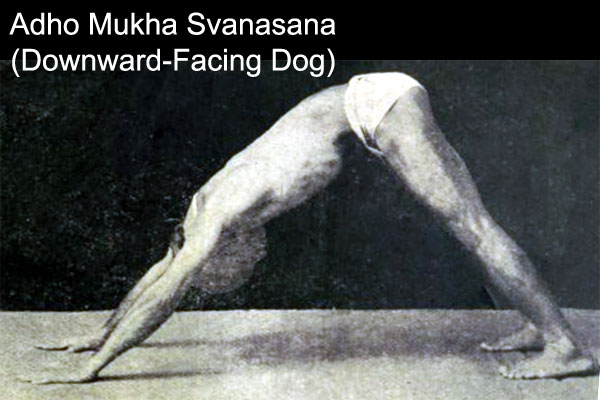
Benefits: Stomach bloating and belching will go away.
Seated Poses
Paschimottanasana
(Seated Forward Bend)
Method: (p77) From Downward Dog, inhale and jump forward with legs going through the arms without touching the floor. You land sitting down with legs straight and together. Hold the inhale, remain seated with gaze on the tip of the nose. Exhale and move the body into a forward bend with arms reaching towards the feet - first 3 fingers grab the big toes. Legs remain straight - don't bend the knees. Hold the exhale and perform Mula Bandha (engaging the perineum muscle) and Uddiyana Bandha (pulling in the tummy). No Jalandhara Bandha (chin to chest) if you are so flexible, your face is on the knees. If not however, do Jalandhara bandha.
In the beginning, there will be intense sensation on the back of the knees, the thighs and lower back. This is normal as long as you don't go beyond your safety edge.
Variation: Jumping through the legs is advanced and requires good core. You can simply walk or take a big step. Instead of holding on the big toes, you can hold the edge of the feet, the balls of the feet or clasp your hands around the feet.
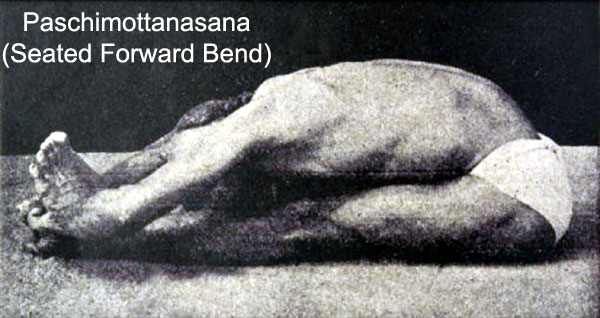
Benefits: All diseases related to the stomach will be cured when practiced daily for 15 mins.
Ardha Baddha Padma Paschimottanasana
(Half-Lotus Seated Forward Bend)
Method: (p83) From seated with straight legs together, bend the right leg so that the right heel rests high up on the left thigh. Right hand goes behind the back and grabs the right big toe. Inhale as you straighten the body up. On the exhale, bend forward towards the left leg with left arm reaching out to the left foot. Left hand grabs the left big toe. Hold the exhalation while doing Maha Bandha Mudra - stay there as long as you can. Inhale and come up and release. Do the other side.
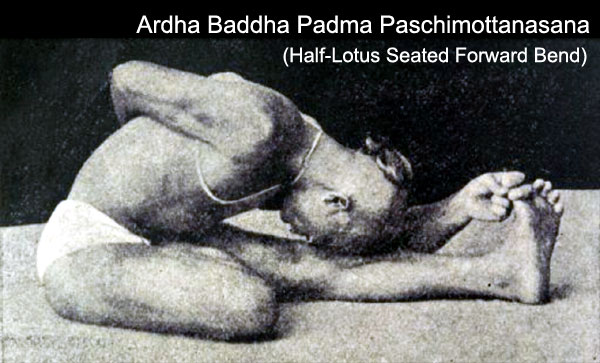
Benefits: All diseases of the lower abdomen are cured. Apana vayu is purified and Kundalini is awakened.
Tiryanga Mukha Eka Pada Paschimottanasana
(Oblique One-legged Forward Bend)
Method: (p85) From seated with straight legs together, bend the right leg so that the right heel rests snugly by the right buttock. Inhale as you straighten the body up. On the exhale, bend forward towards the left leg with both hands grabbing the left foot. Hold the exhalation while doing Maha Bandha Mudra - stay there as long as you can. Inhale and come up and release. Do the other side.
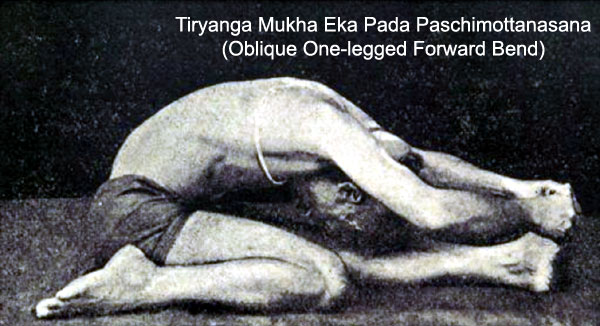
Benefits: Prevents Elephantiasis (enlargement of the balls), all impurities in the nerves, ligaments and joints in the legs are dissolved. Increased strength and speed in walking and running. Nearby nadis are cleansed. Blood circulation is increased.
Krounchasana
(Heron Pose)
Method: (YM2, p21) Seated, left leg straight and right leg bent with right foot snugly squeezed on the right buttocks. On exhale, 2 hands lift the left leg up towards the face. Body is erect, shoulders are pulled back, left leg is straight, knees are together. Hold on the exhale as you pull the leg back. Do the other side.
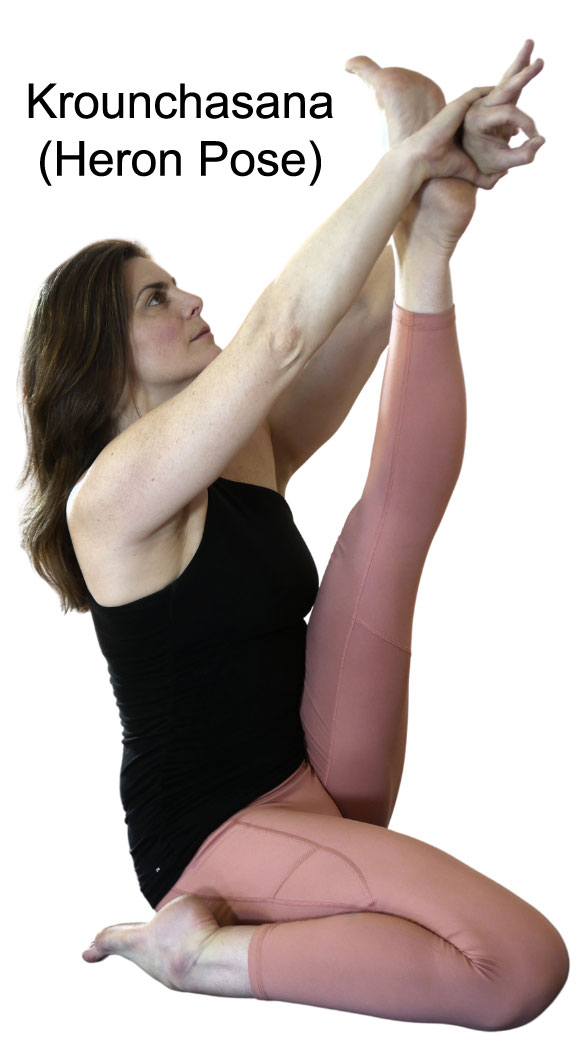
Benefits: Enhances the digestive system and stretches the hamstrings and the body's centerline.
Janu Sirsasana
(Head to Knee Pose)
Method: (p85) This pose is so powerful, it is also considered a mudra - Maha Mudra or The Great Mudra. Doing this properly hastens the awakening of Kundalini.
Seated, with legs straight and together, bend the right leg so that the right heel is between the anus and genitals (this is for Hatha Yoga. For Raja Yoga, the heel should be between the balls and genital) and the thigh is perpendicular to the left leg to form an "L" shape. The left leg should not lean to any side and should remain straight with the back of the knee reaching down to the floor.
Inhale and raise your arms up 'til they touch while keeping the body upright. On the exhale, bend forward on the left leg with head to the knee. Pull the stomach in (Uddiyana bandha) and visualize you are pulling up prana from the pelvic region. Stay here for as long as you can hold the exhalation. Never do an inhalation while on a forward bend. When you have to inhale, look half-way up with a straight back, and exhale on the forward bend again. You can keep doing this for 30 mins before doing the other side.
Variation: The heel can be pressed against the inner thigh of the straight leg - but this is not as powerful since the heel does not activate a mudra. Another version is for the heel on the inner thigh to be lifted so that the ball of the foot is on the mat - this is very difficult and can be painful.
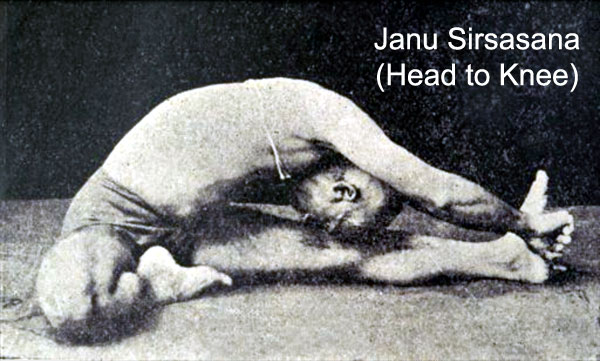
As with any forward bend, I engage Maha Bandha Mudra until I need to inhale. Because this asana is also a powerful mudra in Kundalini awakening, I usually spend a few minutes on one side and do the other side.
Benefits: This is a restorative pose which opens the hip and stretches the hamstring. All urinary diseases will disappear. Spleen problems and diabetes will be cured. Wet dreams will stop (but what crazy guy would want to stop wet dreams?) This practice also reduces the size of the stomach making it easier to do the pose. This asana is also a powerful mudra (thus the name Maha Mudra) in awakening Kundalini.
Marichyasana
(Sage Twist Pose)
Method: (p123) Although called a twist pose, this is more of a bound forward bend. Start with the right leg (in yoga, you always start with the right side first). Left leg straight and right leg bent with knees pointed up, lean forward and wrap the right arm around the right leg. Left arm goes around the back and binds with the right hand. Exhale and do a forward bend on Maha Bandha Mudra.
Variation: Marichyasana has 4 levels.
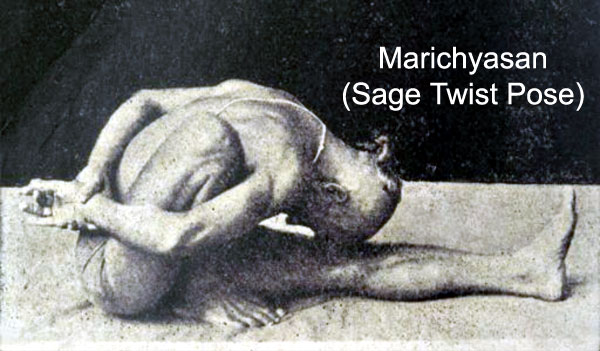
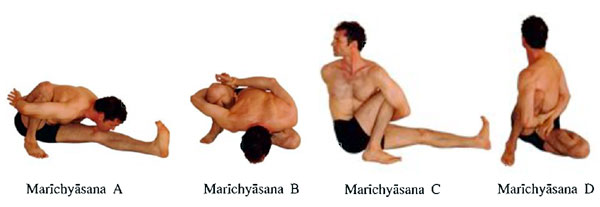
Benefits: Paralysis, jaundice and liver diseases will be avoided, bloating will stop, stomach size remains small, heart is strengthened.
Maha Mudra
(Great Seal Pose)
(YM2, p19) This asana looks simple, but the rishis exalt this pose. It's not only an asana but also a mudra - the great energy seal pose. Why great? You're seated in Ardha Siddhasana (half Siddhasana) where the left heel presses against the perineum (activates the Muladhara chakra), on the forward-bend, you engage Maha Bandha Mudra to awaken the kundalini, mental focus is on the mid-eyebrow (Sambhavi mudra to activate the 3rd eye) and tongue against the soft palate for Nabho mudra (activates the Lalana chakra and induces Amrita flow). So, in this one single asana, you activate so many energy centers. That's why in Hatha Yoga Pradipika, they say that there is no asana like Siddhasana and the fastest way to kundalini awakening is doing the mudras (asana and pranayama make you strong with long life, but bandhas and mudras give you power).
Method: After properly positioning the body, inhale, and on the exhale, forward bend on the right leg keeping the body straight. When lungs are empty, engage Maha Bandha Mudra and stay there (I round my back on the Maha Bandha Mudra). Inhale, halfway looking up, then exhale into a forward bend again with all the mudras. Do as much as you can and do the other side.
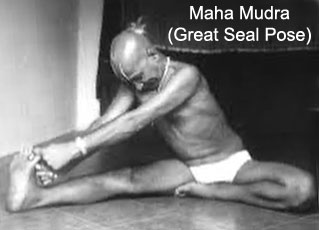
Benefits: This is powerful in the treatment of diabetes, dysentry, stomach and spleen disorders. Neutralizes poisons. Awakens Kundalini.
Maha Mudra blogs:
- Maha Mudra on 20 Essential Mudras of Krishnamacharya
- Maha Mudra on Hatha Yoga Pradipika
- Maha Mudra on Yoga Makaranda
Maha Vedha Mudra
(The Great Piercing Pose)
Maha Vedha Mudra is such as auspicious asana that it's also a mudra (energy seal). On Padmasana, hold the inhale and lift the entire body by pressing the hands on the floor, and come down with a 'thump'. Keep repeating until you run out of air.
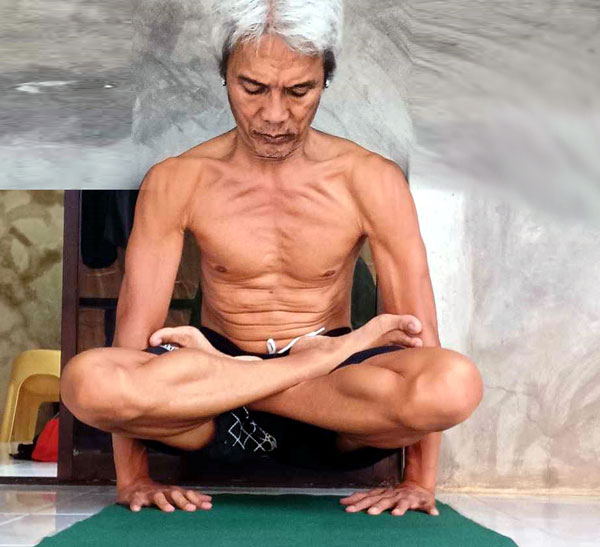
Benefits: This is the catalyst for the Maha Mudra and Maha Bandha Mudra. With the addition of Maha Vedha Mudra, Kundalini awakening is triggered.
Maha Vedha Mudra blogs:
- My August Yoga Practice: A Journal
- Kriya: Wim Hof-Maha Vedha
- Hatha Yoga Pradipika
- Asana (3): Eight Limbs Of Yoga
Ardha Matsyendrasana
(Half Lord of the Fishes Pose)
Description: (YM2, p32) This pose was named after the 'founder' of the Nath Yogi tradition - Matsyendranath. This is the same yoga lineage from which Hatha Yoga Pradipika was based upon. Ardha means 'half', but still, this is one of the most intense torsional twists I can do. The full 'Matsyendrasana' is undoable for me.
Ardha Matsyendrasana A: This is the first time I've encountered this pose. I haven't seen this done in any of the yoga classes I've attended.
Seated with both legs straight and together, bend the right leg and let the foot rest on top of the left thigh, heel as close as possible to the navel. Twist the body and head to the left and take the left arm around the back and hold the shin of the right leg (this is almost impossible for me. I can only manage to hold the inside of the right thigh). Left hand now holds the outer edge of the left foot. Left hand and body are both straight. Breathe here several times before you release. Do a counter-pose before doing the other side.
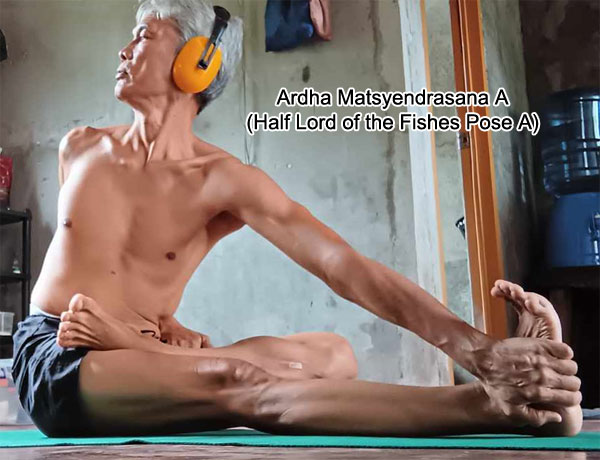
Ardha Matsyendrasana B: This is the more popular version. Seated with both legs straight and together, bend the right leg so that the heel is close to the groin, and the knees and thighs are on the ground. Lift and bend the left leg and put the left foot outside the right knee. Twist the body and head to the left until the right shoulder is on the outside of the left knee. With a straight right arm, grab the inside of the left foot with the right hand. Keep the body straight and breathe here a few times. Release and do a counter-pose.
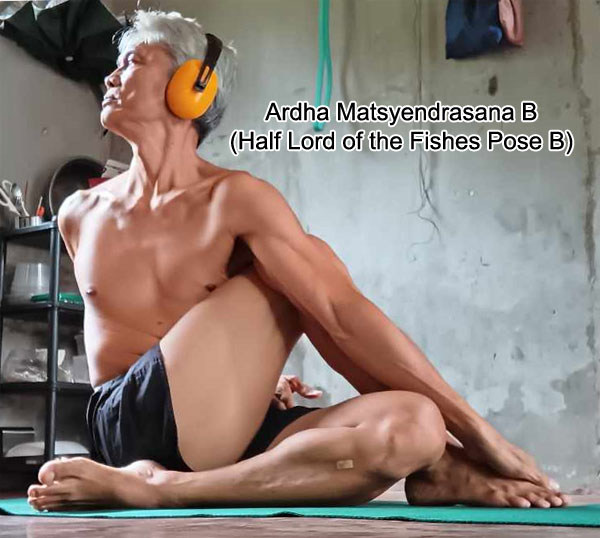
Benefits: This reduces the waistline and aids in digestion and any stomach problems.
Upavistha Konasana
(Wide-Angled Seated Forward Bend)
Method: (p91) Seated with legs straight and spread wide apart, inhale. On the exhale, slowly bend forward until the head touches the floor. The hands also grip the big toes. Hold that exhalation while doing Maha Bandha Mudra. Inhale lifting the body halfway up, back straight and gaze on the nose, and release.
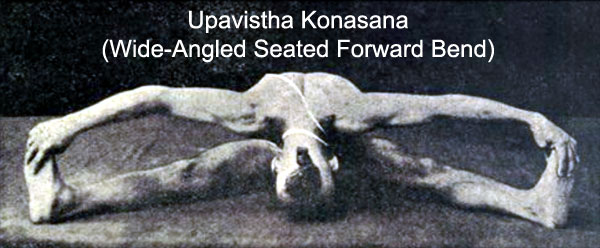
Benefits: Hip pain and knee pain are cured. Pregnant women should practice this 2x/day and all diseases of the uterus will be cured.Women will have regular menstrual cycles in 3 months if these 3 asanas are done daily - Upavistha Konasana, Janu Sirsasana and Baddha Konasana.
Upavistha Konasana
(Wide-Leg Forward Bend)
Method: (YM2, p46) This is a center split. Seated, legs spread out wide, torso upright, chin on chest (Jalandara bandha). On exhale, bend forward until forehead touches the floor. Hands reach out forward. Breathe here.
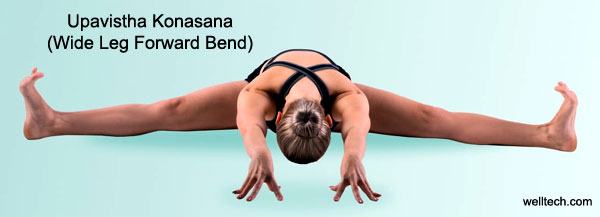
Benefits: Stretches the inner thighs and groin area. This also increases hip flexibility and increases blood flow to the pelvis.
Parsva Upavistha Konasana
(Seated Wide-Angled Side Stretch)
Method: (YM2, p46) Same as Upavistha Konasana but instead of bending forward, the body turns to one of the legs and do a forward bend on it. This is more of a seated oblique forward bend.
Variation: Instead of an oblique forward bend, the body can stretch on its side towards one leg, then the other side. This makes a great side stretch.
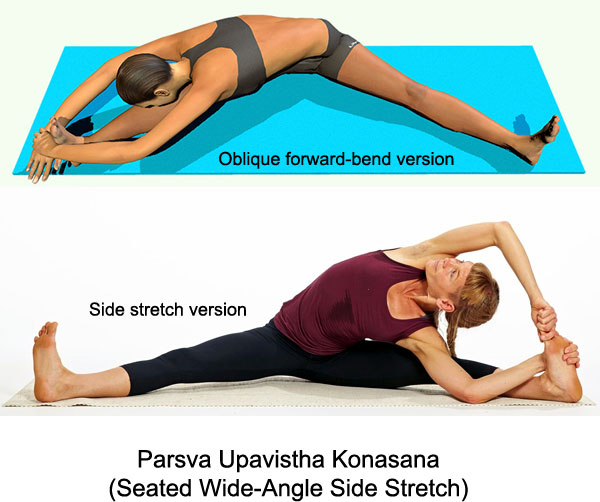
Benefits: Optimizes the kidneys, lungs and nerves and the backside of the legs and hips. Oddly, this cures tonsils too.
Kurmasana
(Tortoise Pose)
Method: (p116) This is a seated forward bend with legs roughly wider than shoulder-width and arms are sideways underneath the legs. This must be done on an empty stomach, preferably 3 hours after a meal - important!
Variation: The legs could also be far apart.
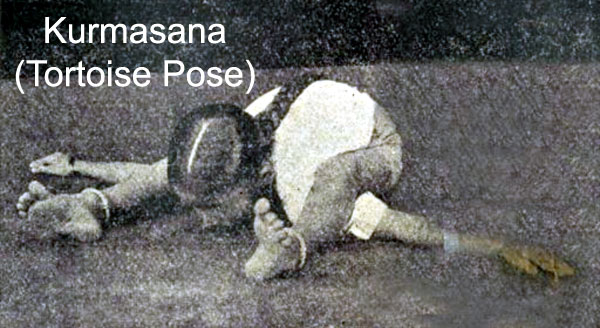
Benefits: Apana vayu is purified, piles or hemorrhoids are cured, night time disturbances are gone. For women, this makes menstruation regular after 3 months with regular practice.
Urdhva Upavistha Konasana
(Upward Seated Angle Pose)
Method: (YM2, p56) Seated upright with legs wide apart, lift both legs up held by the hands. Legs, arms and back straight.
Variation: Spreading of legs apart can be done in my asanas - Headstand, Shoulderstand, etc.
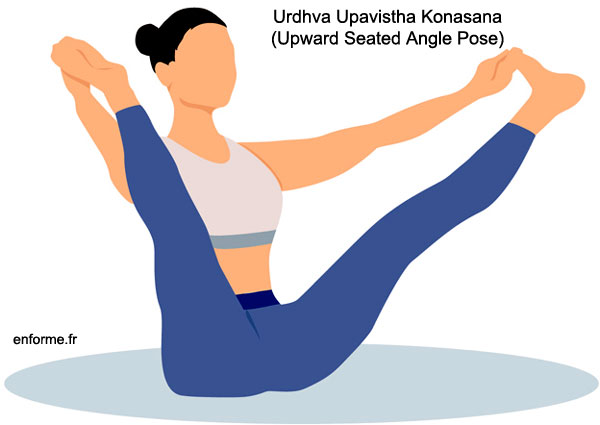
Benefits: This improves balance (balancing the entire body on your sit-bones) and flexibility (of hamstrings and inner thigh)
Baddha Konasana
(Bound Angle Pose)
Method: (p91) Seated, bend the legs so that the heels are pressed against the base of its thigh. The soles of the feet are very close together facing each other. Hands clasp their respective foot. Inhale with straight back. On the exhale, bend forward until the head touches the floor. Hold the exhale and perform Maha Bandha Mudra.
Variation: You can open up the soles of the feet like a book before doing a forward bend.
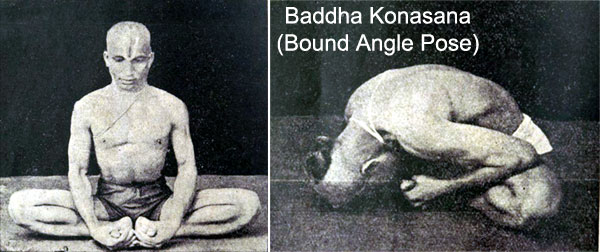
Benefits: Constant dripping of urine, burning sensation when urinating, genital discharges, will go away. This also prevents colon cancer among senior men.
Baddha Padmasana
(Bound Lotus Pose)
Method: (p111) This is a powerful seated pose and an advanced pose - ideal for deep meditation. Padmasana is difficult to begin with. But to bind it with arms through the back and then bend forward, only a few can do this comfortably.
Seated, bend both legs so that right foot rests on top of the left thigh and left foot rests on top of the right thigh. Right arms swings to the back so that right hand grabs the right big toe. Do the same for the left. Drshti on the tip of the nose.
Variation: While bound, head can be tilted back with gaze on the 3rd eye, or body can bend forward with chin on the floor, or back can curve so the forehead is on the floor.
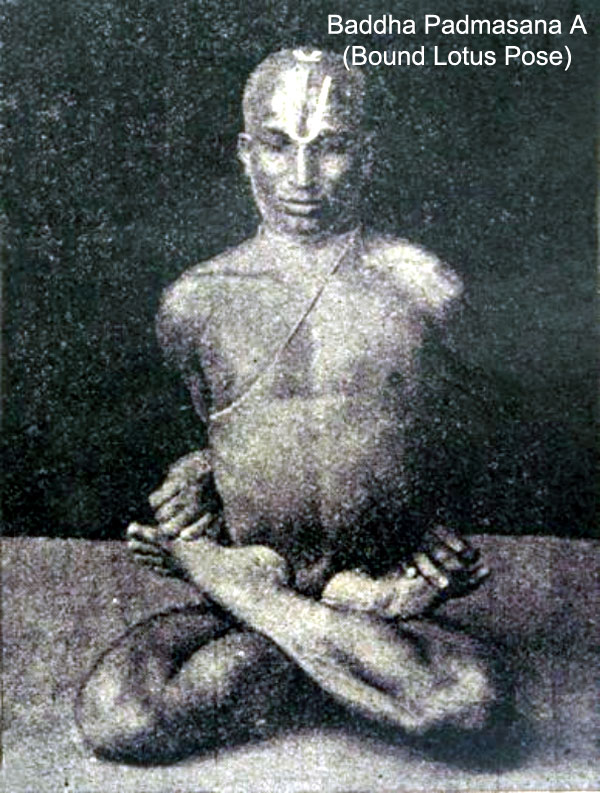
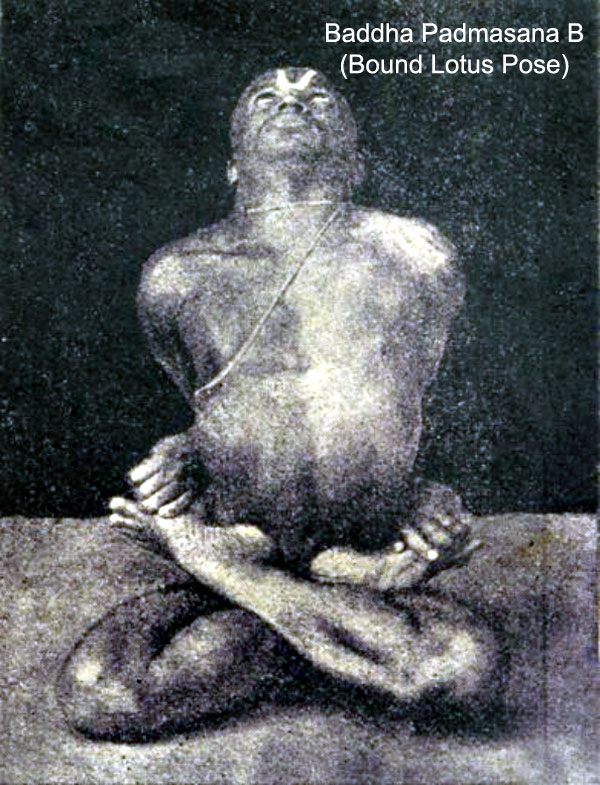
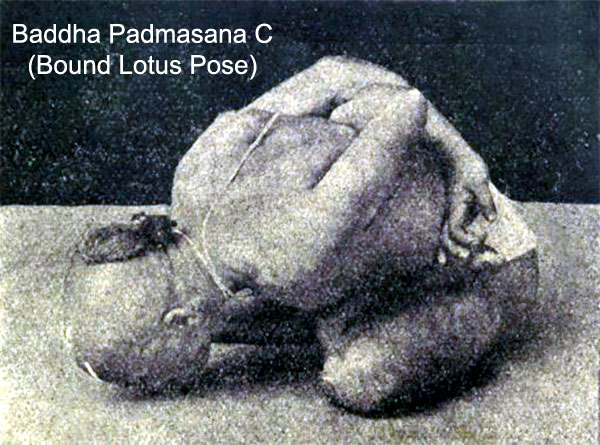
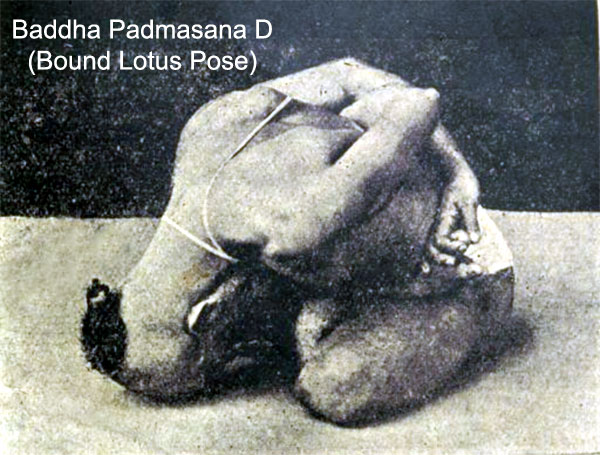
Benefits: This cures all diseases of the lower abdomen.
Navasana
(Boat Pose)
Method: (p116) From Downward Dog, jump forward and let the legs go through the arms so you gently land your upper buttocks on the mat and the legs are straight at 45 degrees. Arms and shoulders are stretched forward (which rounds the back).
Variation: You can also clasp your hands behind your head
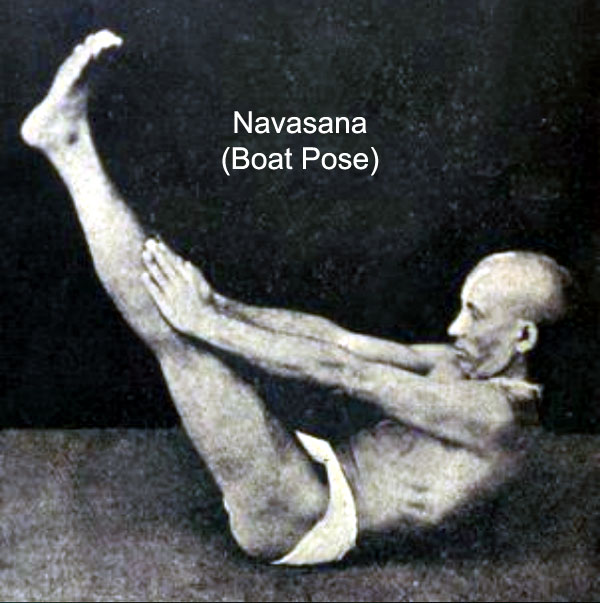
Benefits: Develops core.
Vajrasana
(Thunderbolt Pose)
Method: (YM2, p22) Vajrasana is a seated pose - kneeling down with knees and feet together and the buttocks resting on the parted heels. Body is straight.
Variation: From the position above, you can do a forward bend, a Mandukasana, lie back with parted knees and legs to accomodate the pelvis, backbend with arched belly with the top of the head touching the floor.
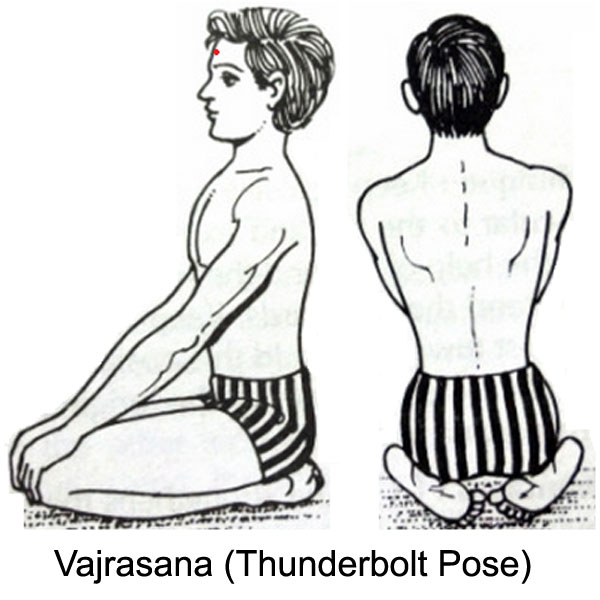
Benefits: Aids in digestion and gas issues, strengthens knees.
Bharadvajasana
(Bharadvaja's Twist)
Method: (YM2, p30) Seated, left leg bent with foot tucked in the buttocks, right leg is bent with right foot on top of the left thigh, right heel touching the belly. Twist so that the right arm goes around the back and right hand grabs the right foot. Left arm is straight and goes over the right thigh, with left wrist on the outside of the right thigh. Inhale to lengthen, exhale to twist. Do breath-holds bothways.
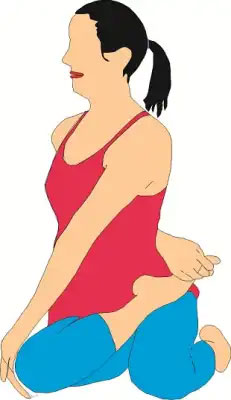
Benefits: Because it's a twist, it's good for digestion and spinal mobility
Squating Poses
Pashasana
(Rope Pose)
Method: (YM2, p38) Squatting with knees together, turn body/head to the right side and wrap your left arm around the knees, right arm goes around the back, and the hands bind together. Breathe here with no retention of breath. Release and do a counter-pose (Krounchasana). Do the other side.
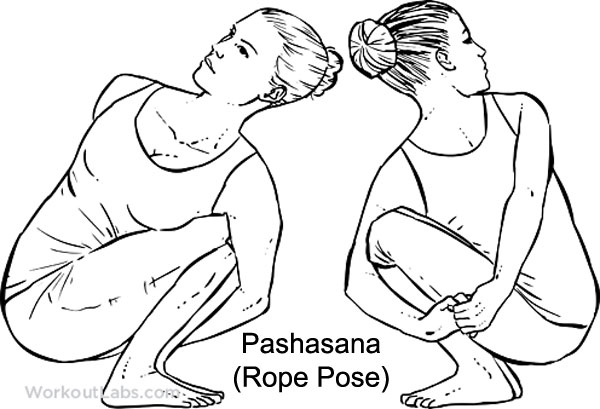
Benefits: This pose binds the 'vital fluid' (Amrita? Why not just say Amrita!).
Malasana
(Garland Pose)
Malasana is usually a transitional deep squat to other asanas like Crow. Depending on body anatomy, some cannot do this pose without losing balance or without lifting the heels.
Method: (not in YM) You squat as low as possible, feet flat on the ground, pointed out, about 90° from each other. Your body anatomy will dictate the optimum distance between your feet. Knees slightly wider than 90°. Hands on Namaste mudra with upper arms pushing the inner thighs apart.
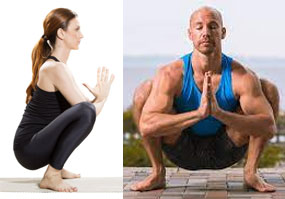
Benefits: This focuses on the Muldhara chakra and ideal to practice with Mula bandha.
Standing Poses
Method: (p67) From Tadasana, spread legs apart, one leg length. Press the palms together behind you for an inverse Prayer Pose. Turn the left foot 90 degress to the left and the right foot 45 degrees to the left as you turn the body to the left. Inhale fully. On the exhale, with a straight back, bend forward, chest to the knee. Empty the lungs and hold. Inhale as you come up. Do the other side. Come back to Tadasana. Keep both legs straight at all times. Benefits: Stimulates the abdominal organs and digestion. Increases blood circulation in the brain (as the brain is below the heart) Method: (p69) While on Tadasana, facing the side of your mat, jump so you land softly with legs spread apart (about 1 leg length). Inhale fully while raising the arms up. On the exhale, bend forward and put palms on the mat shoulder-width. As you bend forward, keep the back straight, and when you can't go further down, you can begin to round the back to take full expression of the forward bend. Bend the elbows as you touch the head on the mat. Hold the breath on empty lungs on this pose. Legs must always be straight. As you inhale, raise the body up until you are upright. Jump back to Tadasana. Variation: B - clasping the hands behind you and swinging them overhead as you go into a forward bend. C - left hand on the right foot as right hand reaches up (torsional twist). D - hands on reverse prayer behind as you do a forward bend. E - hands on Cow Face Benefits: Stretches the back of the legs and enhances digestion, enhances blood circulation in the brain (as the head goes lower than the heart), boosts spinal flexibility (on tortional twists) Method: (p69) On Tadasana, inhale, bend the left leg (you can start with the right too) until the left heel touches the abdomen. Take the left arm around the back until the left hand grips the left big toe. On the exhale, forward bend with a flat back (you can round it when it couldn't go any further). Hold the Bahya Kumbhaka until you cannot. Inhale half-way looking up and continue to take the body upright. Do the other side. Benefits: This removes impurities and deposits from the lower abdomen and facilitates digestion. Method: (p98) With legs wide apart facing the side of the mat, point the right foot towards the end of the mat and bend that leg so that the shin is perpendicular to the ground. Straighten the left leg and adjust the angle of the left foot accordingly (follow your unique body anatomy). Place the right palm on tip of the right foot (with thumb on the big toe). Left arm initially points up and then extends diagonally following the angle of the left leg. On the inhale, left arm reaches where it is pointed as the edge of the left foot grounds itself on the mat - you should feel your left side being stretched. On the exhale, 'at ease' and back to the intensity on the inhale. Keep doing this until satiated. Variation: The palm pressing down on the floor could also be planted on the inside or outside of the foot Benefits: Cleanses the liver, cures digestive issues. Blood flow will be vigorous especially on the ligaments and nerves. Method: (p105) Trikonasana must be done no less than 10 minutes (5 mins each side).
Variation: If standing up hurts, this asana can be done lying down. Benefits: Trikonasana leads to correct and complete clearing of the bowels and urine. This asana is good for older people. Not for pregnant women. Method: (p107) On Tadasana, lift the right leg forward with heel at navel height. Grab the big toe with the 3 fingers of the right hand. Hand and 2 legs are straight. Breathe here. Next exhale, 2 hands grab the right foot as chest/nose bend forward toward the extended leg. Hold this pose in Maha Bandha Mudra for at least 1 minute. Keep straightening the legs. Release and do the left side (always default to doing the right side first when doing asana). Variation: From standing upright with leg in front, swivel the leg towards the side, hold, and then back to front. When releasing the leg, keep the leg raised for a few more breaths before putting it down. Benefits: proper blood circulation in the nerves on legs, arms, hips and back. Better balance since you're on one leg.
Parsvottanasana
(Intense Side Stretch or Pyramid)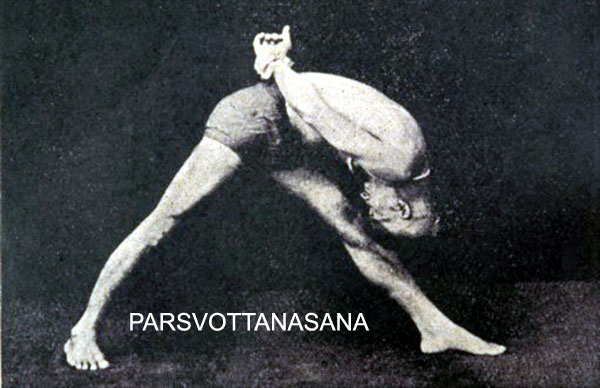
Prasarita Padottanasana
(Wide-Legged Standing Forward Bend)
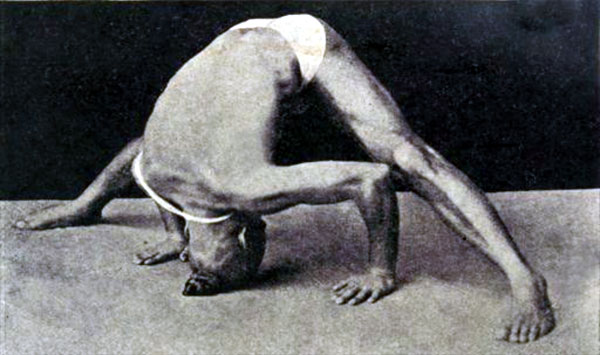
Ardhabaddha Padmottanasana
(Half-Bound Lotus Forward Bend)
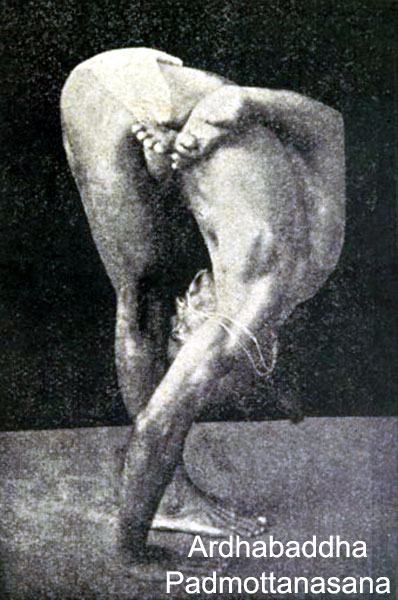
Utthita Parsvakonasana
(Extended Side Angle Pose)
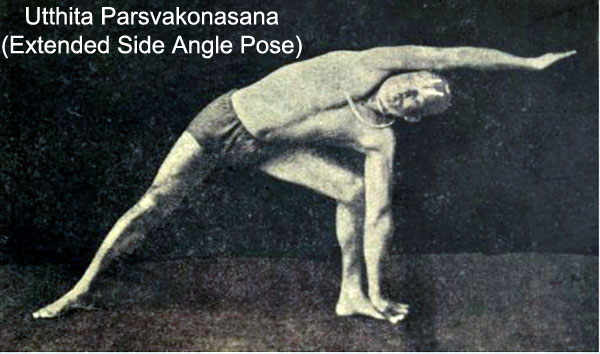
Trikonasana
(Triangle Pose)
With legs spread apart facing the side of the mat, turn the right foot towards the end of the mat with both arms stretched out to the sides. On the inhale, begin to lean the body towards the right, from the waist up - as if you are reaching out for something. On the exhale, bend the body down sideways so that the right hand presses on top of the right foot. Push the hips forward as you pull the left shoulder back, creating a 2-dimensional form on the body - like your back is pasted flat on a wall. Do this side for a min of 5 mins, then do the other side for another 5 mins min.
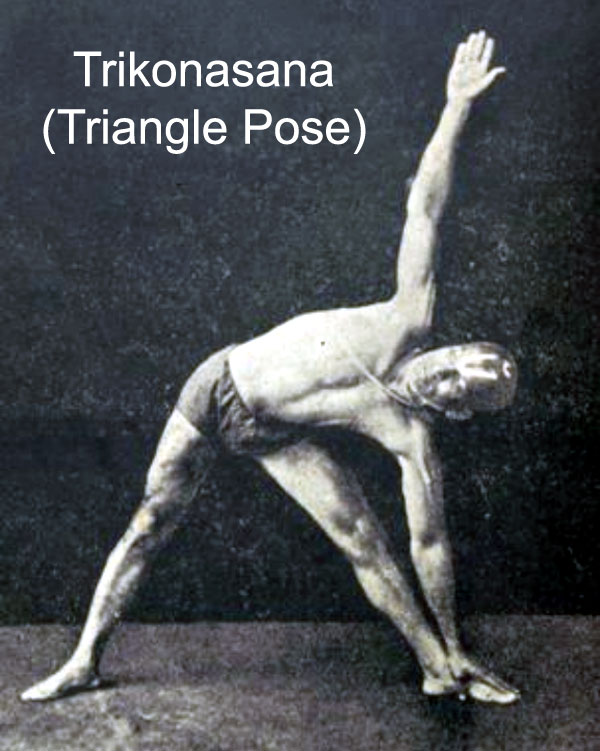
Utthita Hasta Padangusthasana
(Extended Hand To Big Toe Pose)
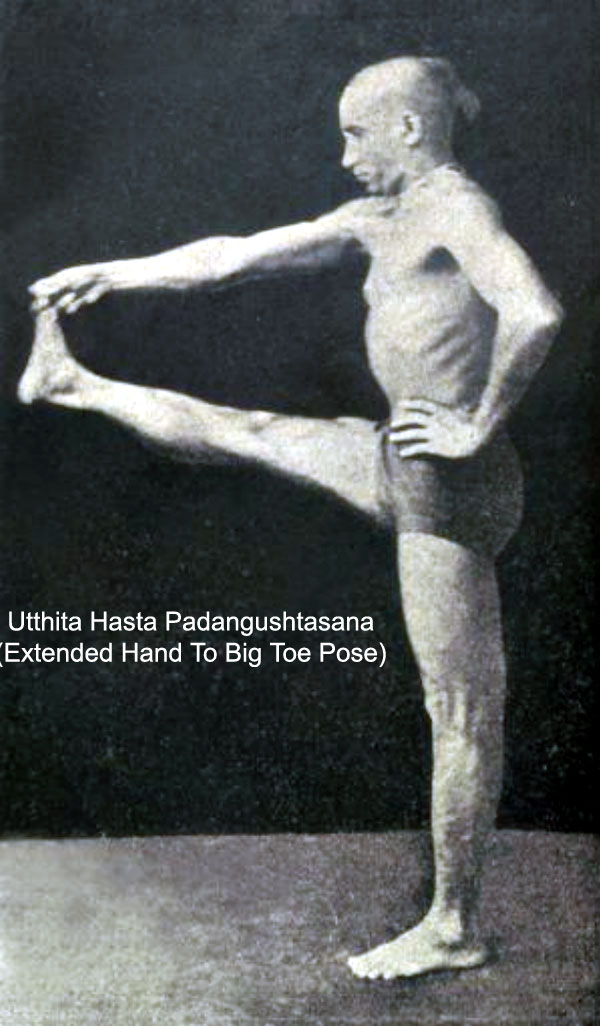
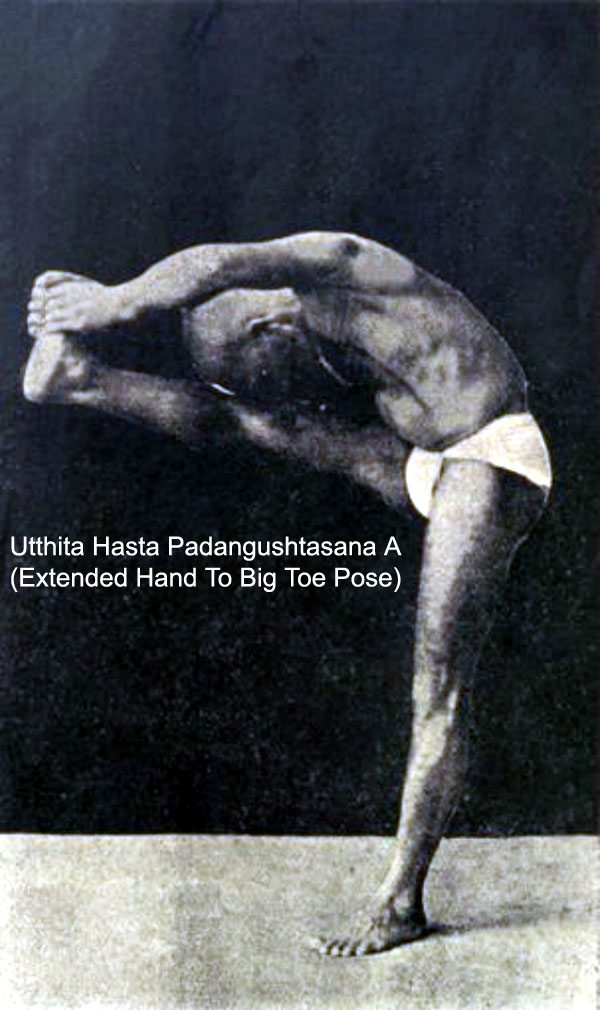
Reclining Poses
Ubhaya Padangusthasana
(Lying-Down 2 Hands-Big Toes Pose)
Method: (p120) Arms and legs should be straight, and this should be held in Maha Bandha Mudra.
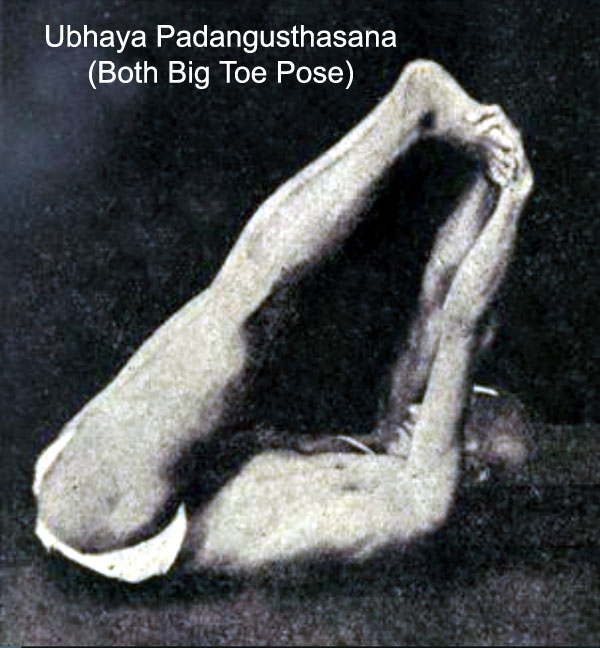
Benefits: Cures piles, indigestion and coughing. Pregnant women should not do this.
Supta Padangusthasana
(Reclining Hand-to-Big-Toe)
Method: (p94) Keep the body flat and active at all times on this pose. While lying down in 'active' Savasana position, EXHALE and lift the right leg up and grab the big toe with the right hand. Hold the exhale and keep the arms and legs straight - don't bend the elbow. Left hand on top of the left thigh. Stay here for a while. Slowly, pulling the right leg in an arching movement towards the floor as the head inches up to meet the leg - but keep the knee and elbow straight. Remain here for a while. Inhale as you release.
Variation: On the peak pose, the leg could be brought down to the side and the head turns in the other direction (aka Suptapada Parsvangusthasana or Supta Padangusthasana B).
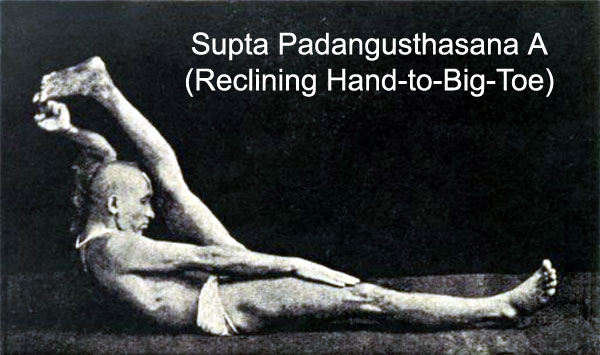
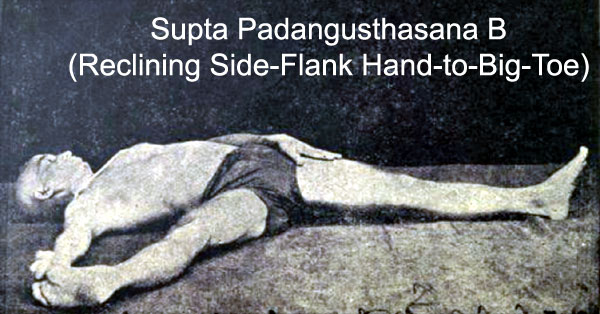
Benefits: This will give tremendous strength to the nerves.
Purvottanasana
(Reverse High Plank)
Method: (YM2, p50) This is a great counter-pose to the forward bend. Seated upright with legs straight and together, palms 1 foot behind the buttocks facing forward and 18 inches apart. On the inhale, lift the pelvis up so that the body is ruler flat from the tips of the pointed toes to the shoulders. Head is dangling back. Breathe here and stay here.
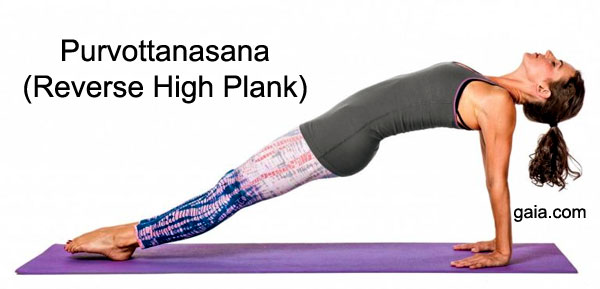
Benefits: The lower back muscles are usually ignored in favor of the abs muscles. This is good way to fortify the lower back muscles especially if you do this on a point-of-failure basis.
Eka Pada Purvottanasana
(One Legged Reverse Plank)
Method: (YM2, p53) The pose is the same as Purvottanasana but with one leg lifted up. This is a great counter-pose to Half-Lotus Seated Forward Bend.
Variation: - The lifted leg could either be straight up or crossed resting on the other thigh
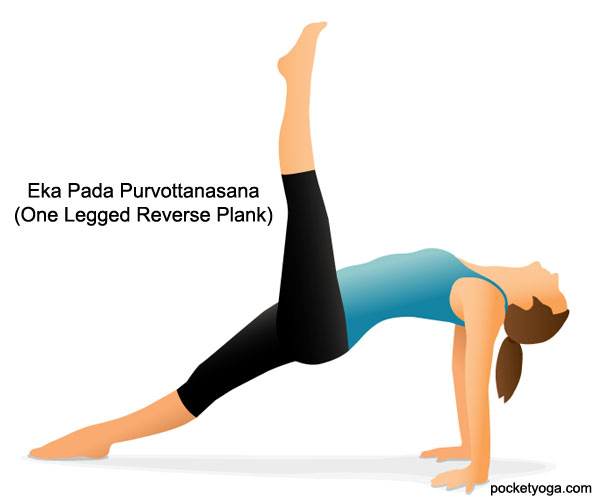
Arm Balancing Poses
Bhujapidasana
(Shoulder-Pressing Pose)
Method: (p) From Downward Dog, jump and land your upper shin on the lower tricep. The feet should not touch the mat. The elbow could be slightly bent to rest the legs on.
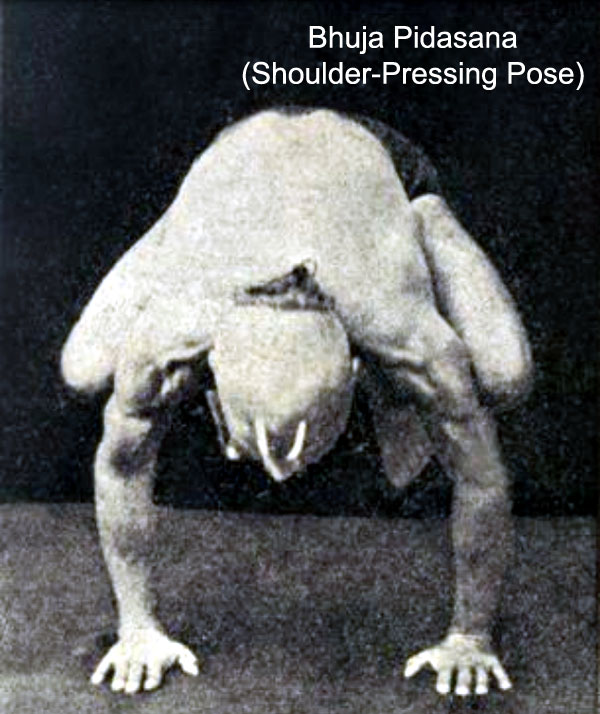
Benefits: This vastly improves the shoulders and cures all ailments related to stomach, heart and brain. Women with menstrual problems should do this and the problem will be cured. Lolasana will greatly develop the core.
Bakasana
(Crow Pose)
Method: (p116) This is an arm-balancing pose. From Downward Dog, you can jump forward and suspend yourself up, or approach it from Malasana (Squat Pose). Arms are straigth and supporting the entire body weight. Knees are high up outside the shoulder. The abs are fully contracted here.
Variation: If the knees are 'resting' on the armpit, it's called a Crane. If knees are inside the arms, then it's Lolasana. Either way, these poses are some of the most difficult and intense.
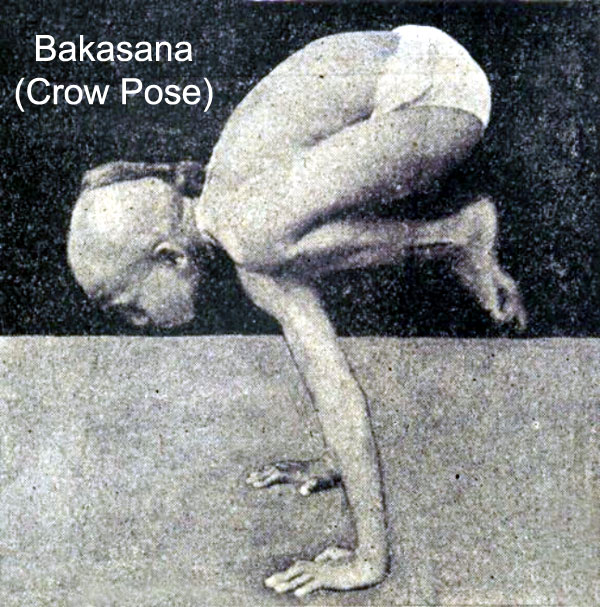
Benefits: This develops the abs, cures constipation and awakens Kundalini.
Mayurasana
(Peacock Pose)
Method: (p150) From squat, take your palms together on the mat facing the feet. Elbows are as close together as possible. Begin to extend your legs back, putting your belly on the Triceps. Keep the body straight and balance the body horizontally. Stay here for as long as you can - even for an hour if you can. Stomach must be completely empty - 4 hours after a meal!
Variation: One hand can be used but this is very challenging.
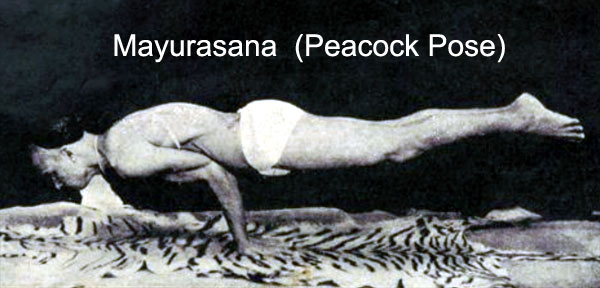
Benefits: All impurities will be expeled from the body. Disease cannot come close. This is perhaps the most detoxifying asana in yoga. Legend has it that it can even neutralize the bite of a snake - like a peacock.
Padma Mayurasana
(Lotus Peacock Pose)
Method: (YM2, p26) This is Mayurasana but instead of straight legs, the legs are in Padmasana. This is actually easier because the legs feel lighter to lift up because they are not extended.
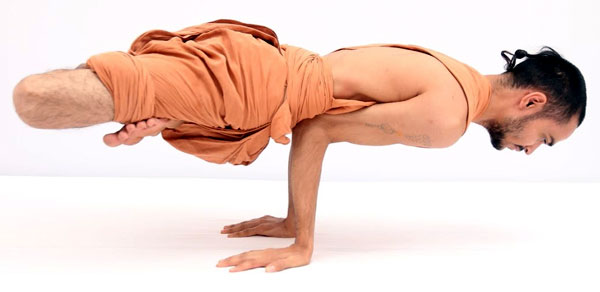
Benefits: Great for digestion
Astavakrasana
(8-Angle Pose)
History: (not in YM) Astavakra is a Vedic sage to whom this asana was named after. Legend has it that in his mother's womb, Astavakra kept hearing his father mispronounce part of the vedic scripture. Either he laughed or corrected his father. This infuriated the father and cursed his son while still in the womb. When Astavakra was born, he was crippled and bent in 8 places - thus the 8-Angle Pose.
In one of his sayings, he said bondage is when the mind craves for something that is not there. Liberation from bondage is not about acquiring what is desired but removing the desire to acquire. If there is no desire, then the bondage cannot exist. The same thing can be said about aversion. This is the cornerstone of Buddhism - no craving, no aversion to attain enlightenment.
Method: Some start from High Plank and put the shin one leg at a time on top of the upper arms. This takes balance and strength to get there, and it takes focus to stay there.
Variation: From Crow, extend the right leg to the side behind the right arm. The upper right arm supports the weight of the right leg. Then extend the left left towards the right, in front of the right arm, and put the left foot on top of the right foot.
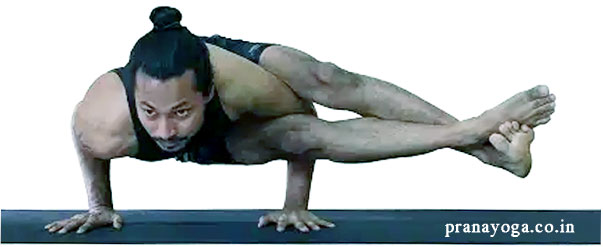
Benefits: This develops strength, balance and focus
Lolasana
(Pendant Pose)
(not in YM) Lolasana requires strong abdominals to do. If you dont' have one, then this is a good practice to develop it.
Method: From Vajrasana, move the body forward to balance the weight, hands on the floor on the sides of the thighs, inhale or exhale, hold the breath, and lift up. Resume breathing while holding this pose.
Variation: To those who cannot but want to do it, see-saw the toes, left and right on the floor, so it's semi-propped. As you develop strength, try to 'hang' longer between left and right toes.
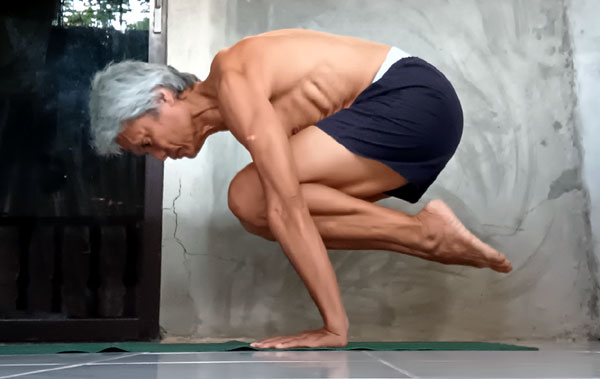
Benefits: develops strong front abdominals, wrists and shoulder muscles. Doing lots of slow Chaturangas help the shoulder muscles to do Lolasana.
Brahmacharyasana
(L-Sit)
(not in YM) Next to Manna, the L-Sit is probably the most difficult ABS-seated pose to do. It requires strength and technique to accomplish.
Method: Seated with legs straight and together, stiffen your legs and thighs, move your body forward to even-out the weight, and lift the entire body up by pushing the palms against the floor. Hold as long as you can.
Variation: Like Lolasana, to develop this ability, you can see-saw your heels left and right to prop the body weight.
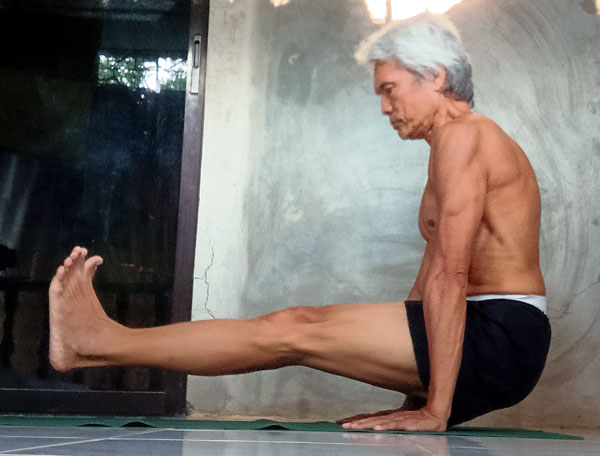
Benefits: This develops a strong front abdominals and tones the thighs
Manna
(Manna)
(not in YM or in yoga) Manna is not part of traditional yoga asana (maybe it is, after all, during Adi Shankaracharya's time, there is said to be 84,000 asanas) and more understood in the gymnastics world. This is perhaps the most difficult abdominal exercise to do. Only a few people on the planet can do this - I can't.
Method: Start with L-Sit, then lift the legs towards the forehead while keeping them straight. Then arc the pelvis up and towards the ceiling, as far as it will go. Hold.
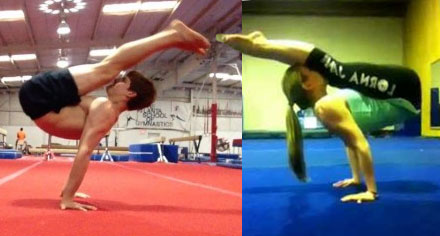
Benefits: This is so difficult that maybe you see God when you finally get to do this. Good luck!
Inversion Poses
Supta Konasana
(Reclining Angle Pose)
Method: (p120) From Plow, spread the legs wide apart and straight. Fingers hold the respective big toes with arms straight. Weight should be on the shoulders. Hold this pose on Maha Bandha Mudra.
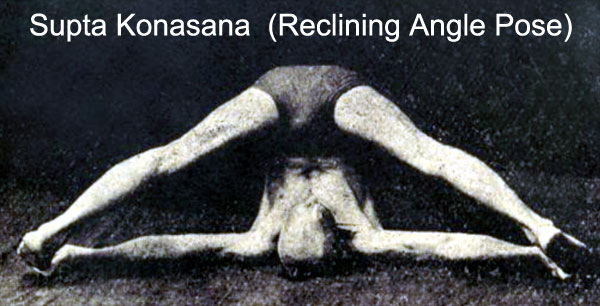
Benefits: Body becomes alert and vigilant, sluggishness disappears. Elimination is enhanced. Women: if there is menstrual pain, this should be practiced together with Upavistha Konasana and the pain quickly disappears. If a woman does NOT want to get pregnant, this should be practiced together with Krounchasana.
Pincha Mayurasana
(Feathered Peacock Pose)
Method: (YM2, p26) This is an inversion with entire body supported by the hands and forearms.
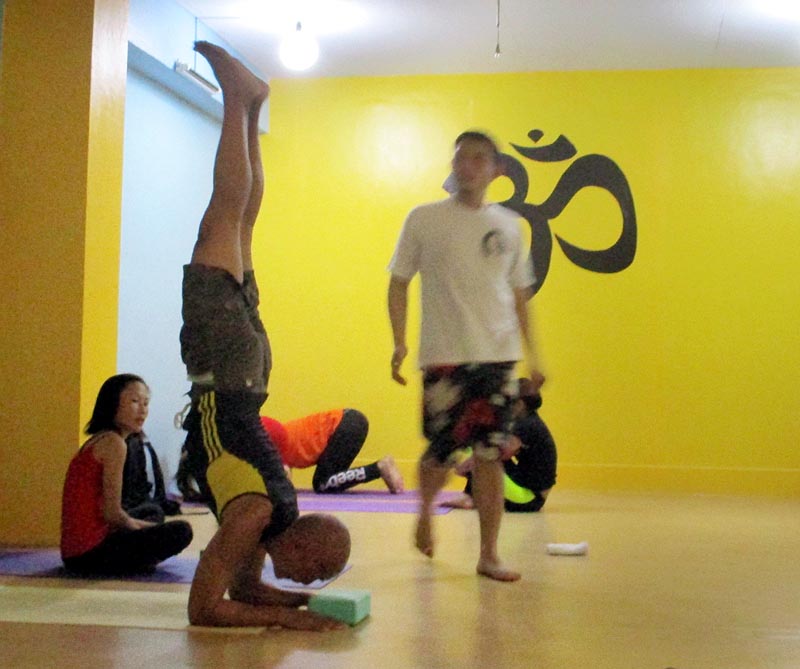
Benefits: Like all inversions, this delays the aging process and puts the organs back where they should be.
Sirsasana
(Headstand)
(YM2, p13) Sirsasana is an auspicious pose because it's not only an asana, but also a mudra (an energy seal that moves prana vayu within its respective nadi) at the same time. This delays/reverses the aging process and displaces the internal organs back to their proper places. The head supports the entire body weight. Thus, Sirsasana is the "King of Asanas".
Method: Kneel down, interlace the fingers and place the forearms on the mat with elbows about shoulder-width apart. Close your eyes - this is unusual as asanas require a drshti(fixed gaze). FYI, this is actually easy but closing eyes on a Tree pose is much harder. Straighten legs, move the pelvis forward to unweight the legs. The legs should lift up. Keep raising the legs until fully upright with toes pointed. Engage Mula Bandha at all times, but only engage Uddiyana Bandha after exhalation. Try to slow down the breathing to 2 full breaths/min. Stay here as long as possible but on a progressive basis - one minute first, then 2 mins, and keep progressing with your practice. Don't push it hard early on even if you think you can do it - you might feel the pain the next day.
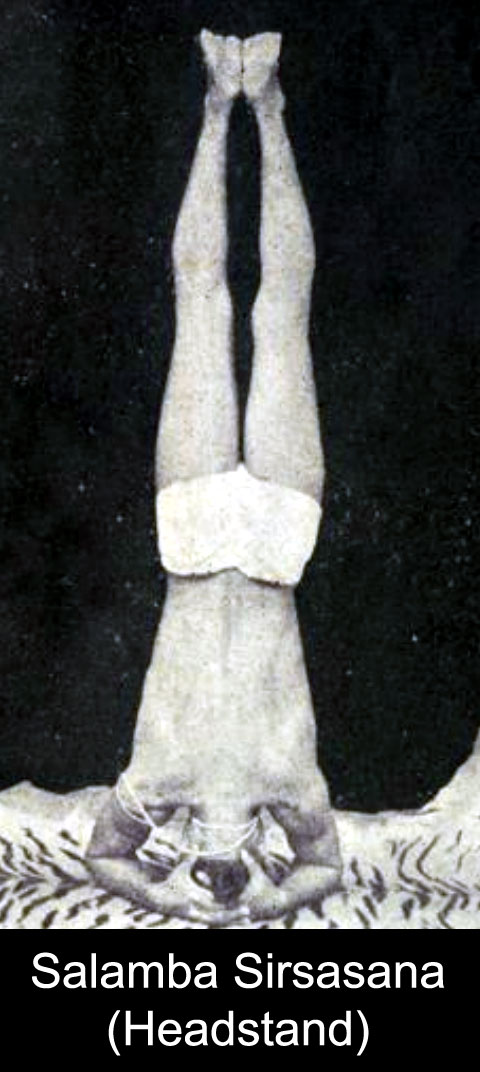
Variation:
Sirsasana Viparita Konasana - on headstand but the arms are straight and extended forward, palms up, 2.5 feet apart. Legs can be spread apart.
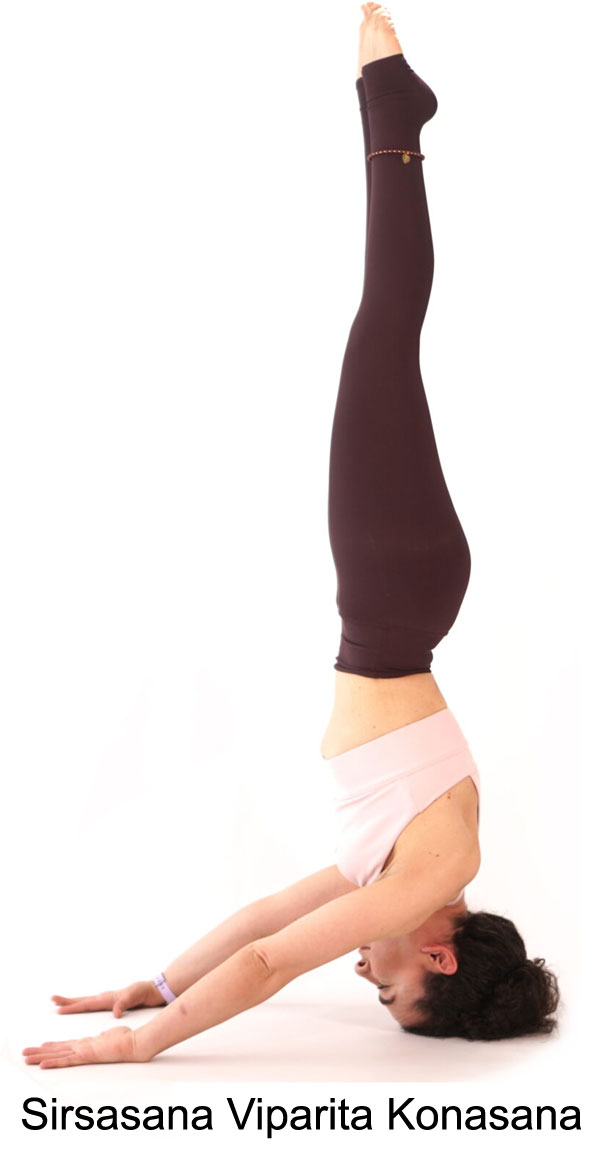
Variation:
Sirsasana Dvipada Viparitakarani - while on headstand, exhale while lowering both legs (keep them straight) until they touch the floor. Hold and breathe here.
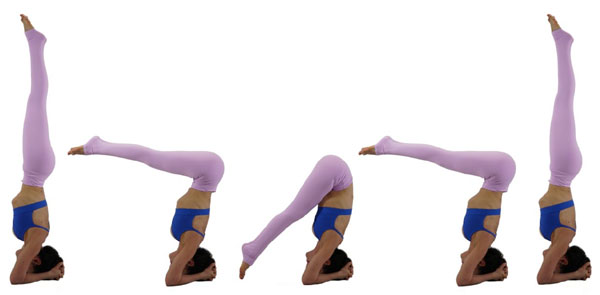
Variation:
Sirsasana Ekapada Viparitakarani - same as Sirsasana Dvipada Viparitakarani (above), but lowering down the leg one at a time, touching the corresponding outstretched hand.
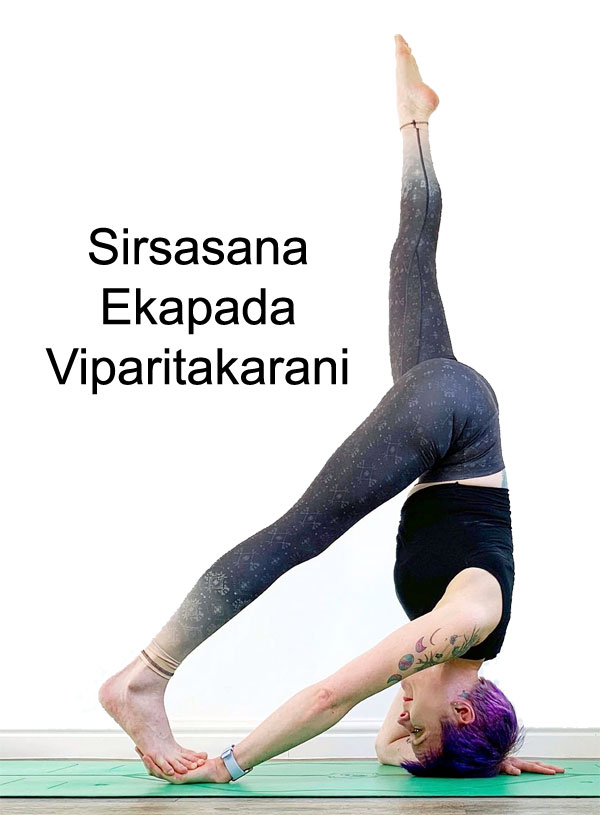
Variation:
Mukta Hasta Sirsasana - (aka Tripod) on headstand but the elbows are bent and palms pressed on the floor pointed to the face
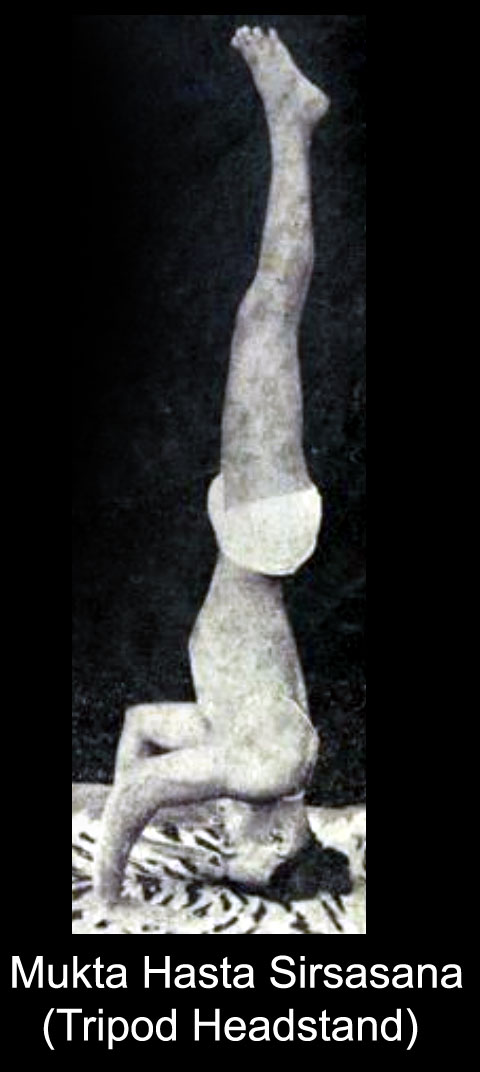
Benefits: The inversion displaces the organs and restack them back to put them in their proper places again. The reversal flow of Amrita results in reversal of the aging process.
Warning: This is an advanced pose. Lose weight first before doing this. Use a wall when practicing. Have someone spot you. Do Sirsasana first, then Sarvangasana second, then Paschimotanasana for counter pose - in that order.
Click for more writings on Sirsasana.
Niralamba Sarvangasana
(Shoulderstand)
Method: (p123) Hold this pose on the exhale. Don't do an inhale here. Chin to the chest, arms and legs straight, gaze on the 3rd eye.
Variation: There are 2 types - Salamba and Niralamba.
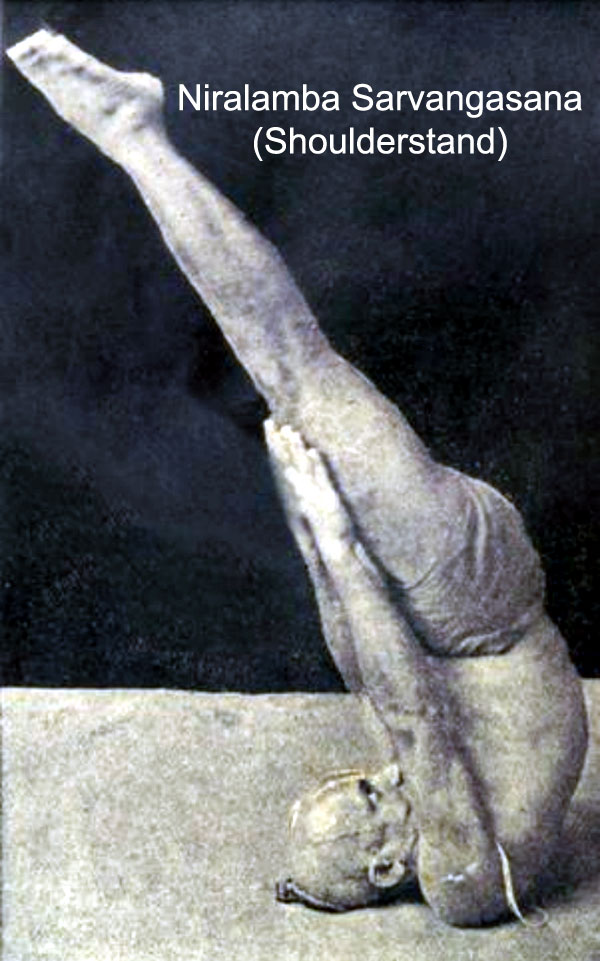
Benefits: Stomach becomes slim, and stomach illness disappears (gas, pain, indigestion), cures insomnia when done with asana paristhiti. To get the full benefits, the vinyasas leading to the peak pose should be done.
Salamba Sarvangasana
(Shoulder Stand)
Of all the asanas, SIRSASANA and SARVANGASANA hold the top place as they give the greatest benefits. But they both need to be practiced with caution. Ideally, they should be practiced in the morning, Sirsasana first, followed by Sarvangasana.
Method: (p154) From Savasana, lift the legs vertically up and support the body with the 2 hands holding the back. Ideally, there should be a straight line from the tips of the toes to the shoulders.
Variation: The other Sarvangasana is the Niralamba Sarvangasana.
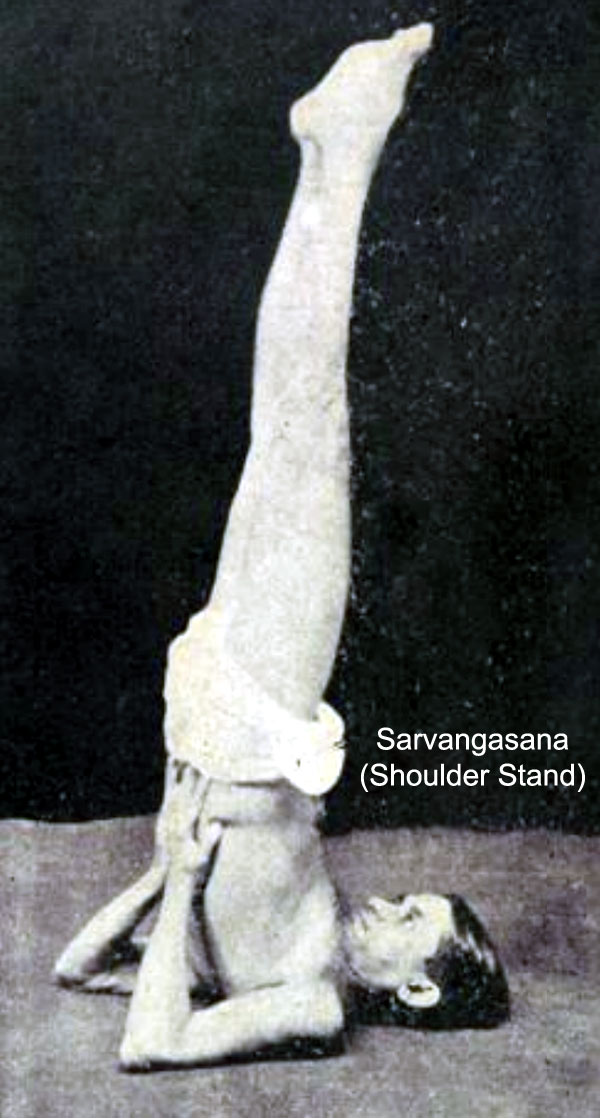
Benefits: SARVANGASANA (Shoulderstand) and SIRSASANA (Headstand) are the queen and king of asanas. Together, they facilitate the awakening of Kundalini. Also, they revert the aging process. Because of the inversion, the sensory organs in the face are below the heart thus blood flow to these organs are enhanced. Inversion also displaces the internal organs and neutralizes the accumulated compaction of gravity on them. When back into the upright mode, the organs are placed optimally where they can function properly.
For more about Sarvangasana and Sirsasana, click here: Yoga Makaranda II: Sirsasana & Sarvangasana
Eka Pada Sarvangasana
(One-Leg Shoulderstand)
Method: (YM2, p55) On Halasana (Plow), inhale and lift one leg up towards the sky - keep the leg straight. Breathe here. Exhale and bring it back to Halasana. Do the other leg.
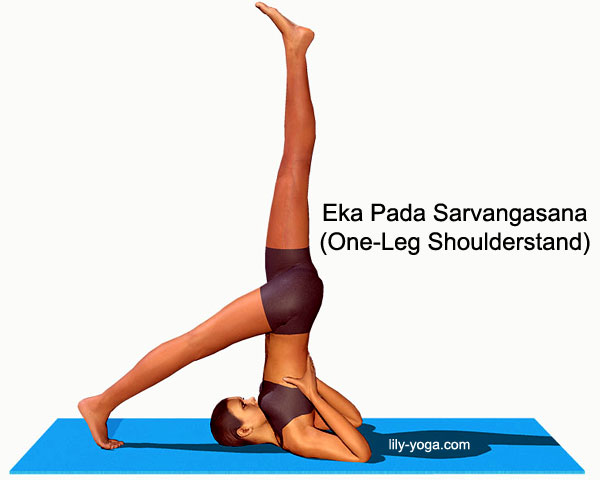
Halasana
(Plow Pose)
Method: (p150) This is a mild inversion (heart is still above the head). In Savasana Pose, lift the legs all the way up and back so that the tips of the toes are touching the floor above the head. Arms are straight and hands can clasp each other.
Variation: Toes could also be tucked under.
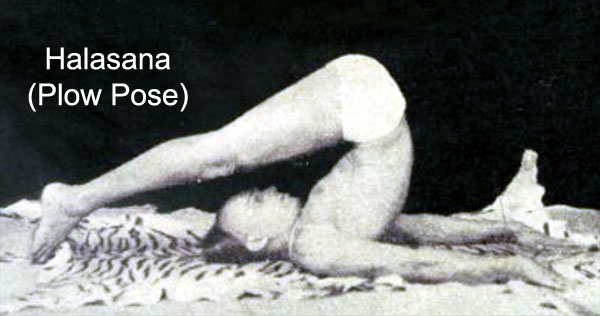
Benefits: Improves blood pressure, stretches the back muscles, neck, shoulders and spine, and improves digestion.
Parsva Halasana
(Side Plow)
Method: (YM2, p59) From Shoulderstand, exhale and lower both legs towards the right (must be the right first) while keeping the torso centered. Inhale and come back to center. Exhale and do the other side. No breath retention.
Variation: Before doing the next side, you can do Halasana at the center, as a way to transition smoothly. Another variation is to do one leg at a time instead of both.
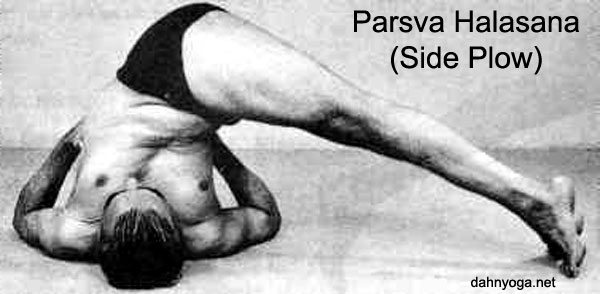
Benefits: Optimizes the liver and spleen.
Karnapidasana
(Ear To Knee Pose)
This inversion pose is best done as part of a flowing Closing Sequence in the Ashtanga Primary Yoga: from Headstand (this should come first before Shoulderstand), to Shoulderstand, Halasana and then Karnapidasana, to Urdhva Padmasana (inverted lotus), Pindasana (hugging the inverted lotus), Matsyasana (Fish as a counter-pose).
Method: (YM2, p41) From Plow/Halasan, bend the knees until they fall beside the ears. Breathe!
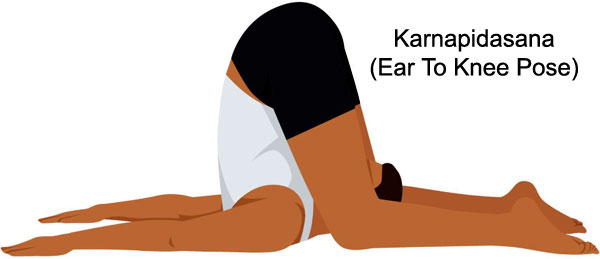
Benefits: This is a great pose to reverse piles with equal antara and bahya kumbhaka. This also cures ear-related diseases. For deafness, it is best to do breath-retention. This also reduces the waistline.
Supta Vajrasana
(Supine Thunderbolt Pose)
Method: (YM2, p41) On Vajrasana, begin to slowly lie back, arching the back until the top of the head touches the floor.
Variation: This pose is similar to the Matsyasana, the Fish
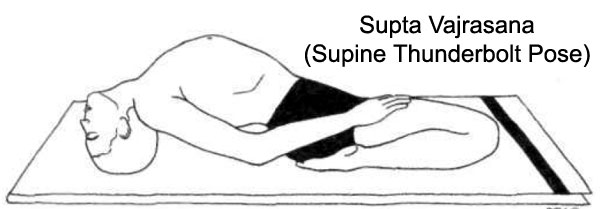
Benefits:
Setu Bandhasana
(Bridge Pose)
Method: (YM2, p45) Lying down on the mat facing up, pelvis is lifted up, back is arched, top of the head on the floor, legs are straight, toes are pointed and arms folded by the chest. The muscles activated here are the hamstrings and buttocks.
Variation: An easier version, one that is mostly done in studios, is to bend the knees. The muscle activated here is the buttocks.
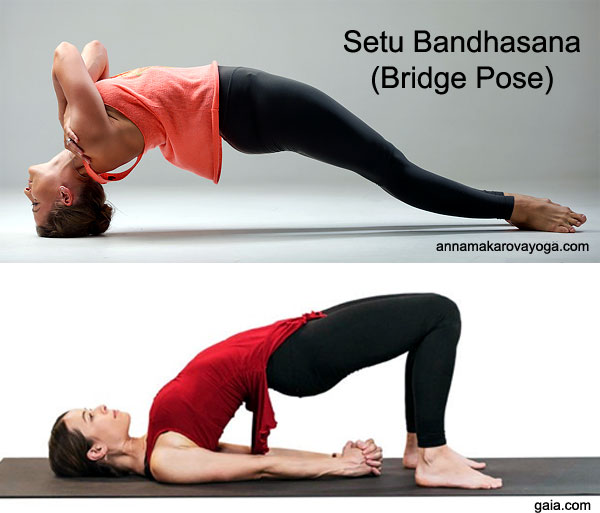
Benefits: Firms up the buns and the hamstring. Cures piles.
Uttana Mayurasana
(Bridge)
Method: (YM2, p61) This is similar to Setu Bandhasana except that the hands support the lower back and the shoulders are on the mat.
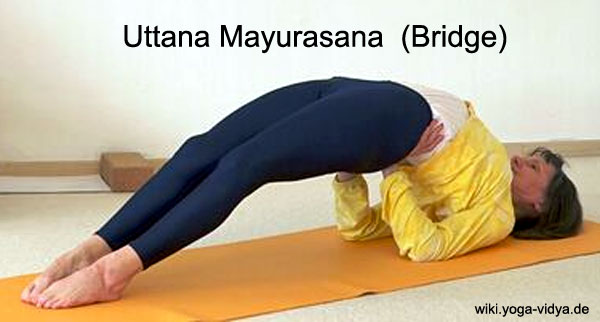
Eka Pada Uttana Mayurasana
(One-Leg Supported Bridge)
Method: (YM2, p63) same as Uttana Mayurasana but one leg is lifted up. While the body remains arched, both legs are straight. Repeat on the other side.
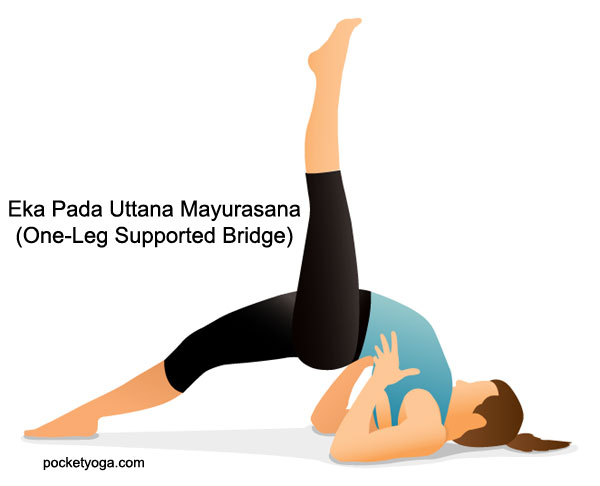
Uttana Padasana
(Raised Leg Pose)
Method: (YM2, p45) Same as Setu Bandhasana (top of the head on the floor, back is arched) but pelvis on the floor and legs together, straight and raised. Arms are parallel to the legs. This pose is essentially Matsyasana (Fish Pose). This is a good counter pose to Halasana (Plow).
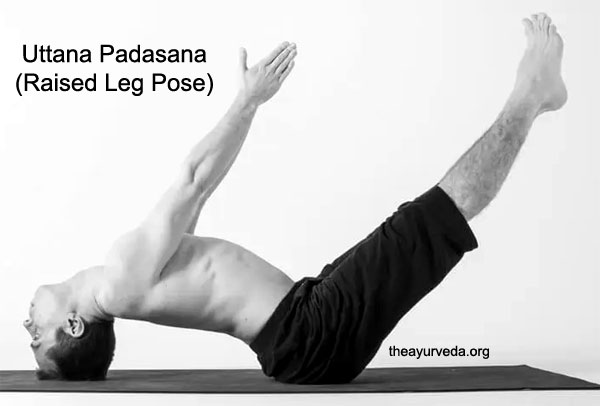
Benefits: Reboots the body from doing Halasana
Face-Down Poses
Bhekasana
(Frog Pose)
Method: (YM2, p30) From Tadasana (standing Mountain Pose), interlace the hands behind you with straight arms. As you inhale, bend back and pull the shoulders back. Exhale as you come back to Tadasana. This is the backbend warm-up.
Inhale and lift the arms up sideways and interlace the fingers with the palms upwards. Arms are straight. Exhale and do a forward bend. Inhale halfway up, and jump/step back into high plank. Exhale and do Chaturanga but going all the way down, body straight and lying on the ground. Inhale, head and chest up. Exhale, bend the legs and hold them down, making the heels touch the floor. Keep the chest up and tilt the head as far back as possible. Stay here with slow breathing, no kumbhaka - don't rush the breath! Reverse the process but do a Downward Dog as a counter-pose until you come up to Tadasana.
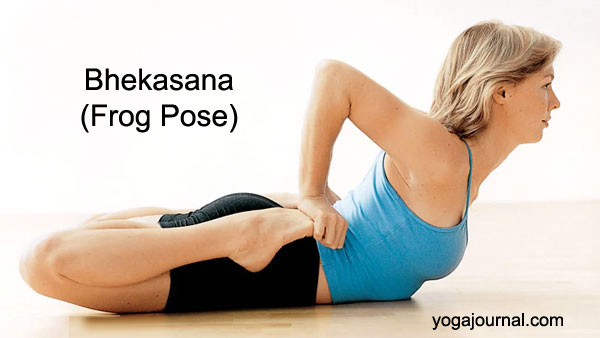
I don't get a full back stretch or thigh stretch by doing both legs together. I find it more effective to do the Ardha Bhekasana - Half Frog Pose (picture below). Here, I only do one leg at a time. I even do a slight body twist to enhance the stretch.
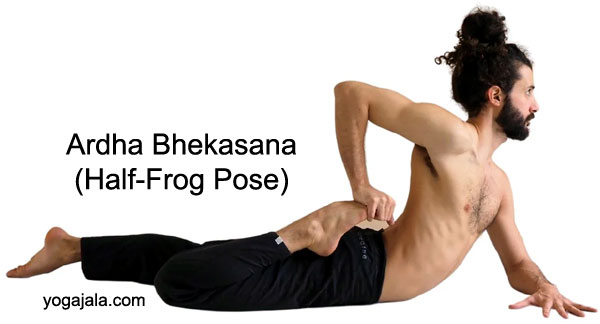
Benefits: This relieves backache and stomach ache. It tones the kidneys and bladder.
Advanced Poses
Ekapada Sirsasana
(Leg Behind the Head Pose)
Method: (p128) Important! Do equal breathing ratio. Torso should be straight, head leveled, and gaze on 3rd eye. Hold the pose on an inhale.
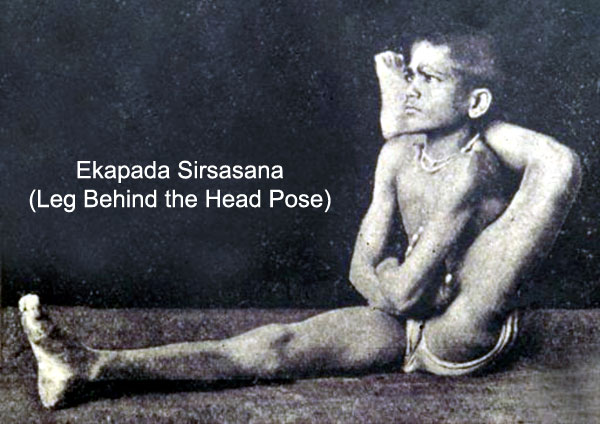
Benefits: Piles/hemorrhoids are cured. Neck can carry heavy loads, aids in Kundalini awakening.
Dvipada Sirsasana
(Two Feet Behind the Head Pose)
Method: (p128) This pose is only for the rare few. Right leg goes first. Hands in prayer pose at the Muladhara chakra.
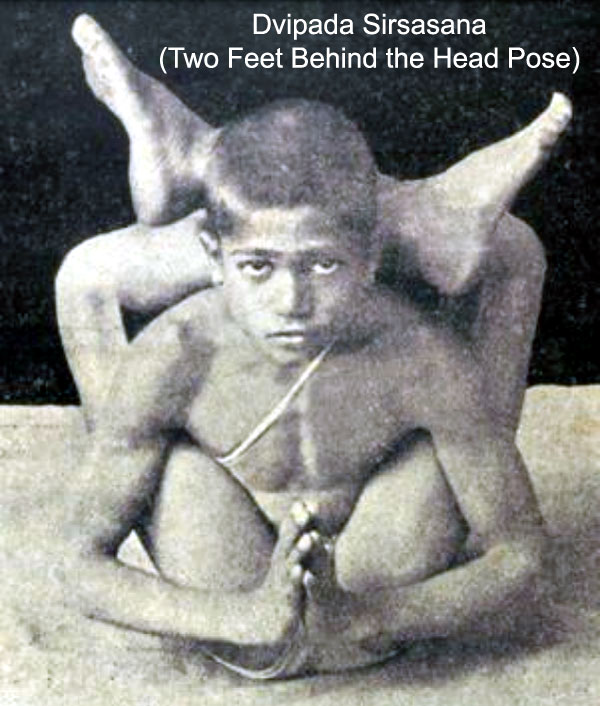
Benefits: Diseases of liver, spleen and stomach will go away. Muladhara chakra is purified. Women prone to miscarriage should practice this and stop when they want to conceive. Those who practice this regularly cannot have children.
Yoga Nidrasana
(Yogic Sleep Pose)
Method: (p131) This is similar to Dvipada Sirsasana (previous pose) but reclining and hands are by the base of the spine with left hand grasping the right wrist.
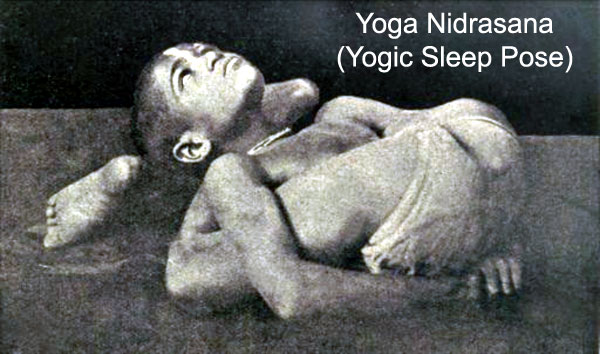
Benefits: Tuberculosis, bloating, edema will be cured. Promotes long life, helps put Prana vayu under control. Not for pregnant women.
Buddhasana
(Awakened Pose)
Method: (p135) Right leg goes over the head and under the left armpit. Right hand holds the left wrist. Head lifts up and body is straight.
Variation: Buddhasana B - same as above, but the hands bind from the behind the body, right hand holding the left wrist.
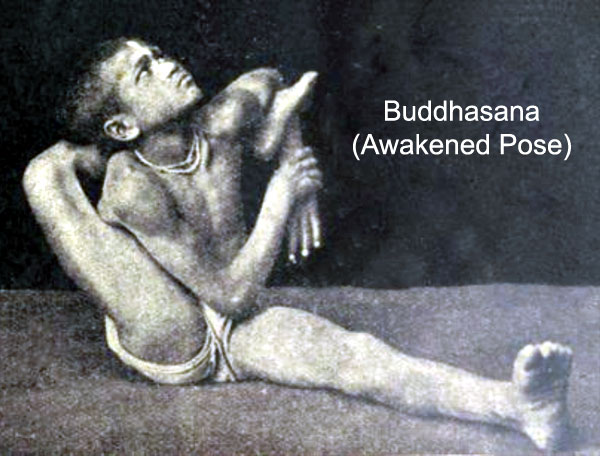
Benefits: Enhances blood circulation, cures hunched back, purifies the chakras, develops Kevala kumbhaka, cures long-term persistent fever.
Kapilasana
(Kapila Pose)
Method: (p135) From Buddhasana B, exhale and do a forward bend
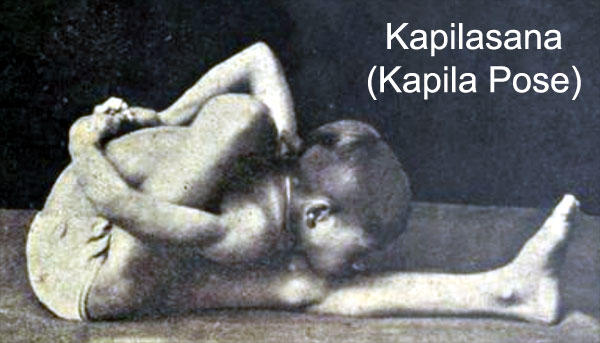
Benefits: Conditions the chakras paving for higher meditative levels.
Bhairavasana
(Destroyer Of The Universe Pose)
Method: (p137) Seated with the right leg behind the head, lie down flat on the back and lock the arms by the elbows. Inhale and lift the head up (from neck up) and gaze on 3rd eye. Relese and do the left side.
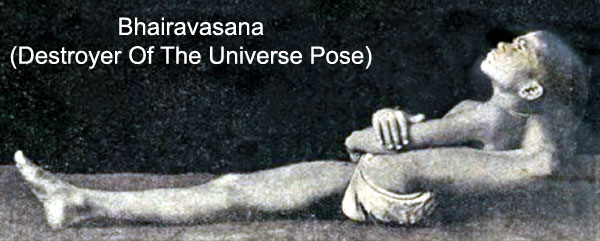
Benefits: Great for women who don't want children.
Cakorasana
(Flight of the Cakora Bird Pose)
Method: (p) This is not Chakrasana! This asana follows the flight of the cakora bird. Seated with one leg behind the head, press both palms on the mat and lift the body up. Try to lift the extended leg up so it's 45 degrees from the mat. Gaze on the 3rd eye.
Variation:
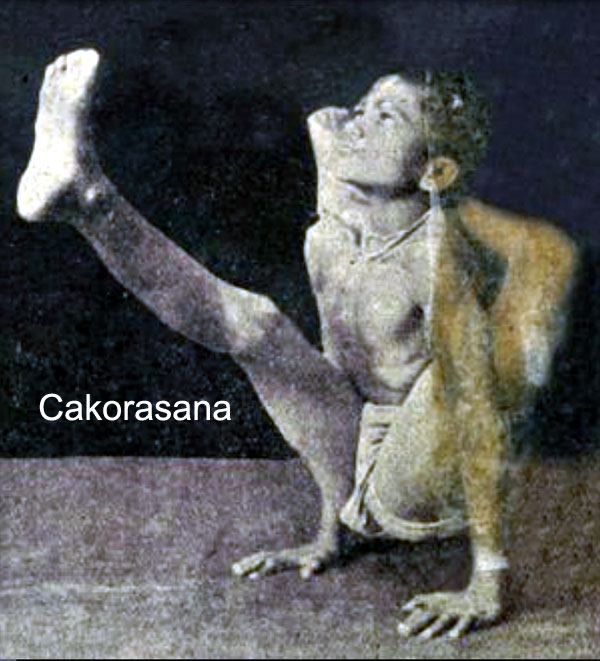
Benefits: Tremors in the wrists and arms are cured.
Skandasana
(Side Lunge Pose)
Method: (p140) Seated with the leg behind the head, do a forward bend with arms extended forward and the palms together. Extended leg is between the arms. Do the other side.
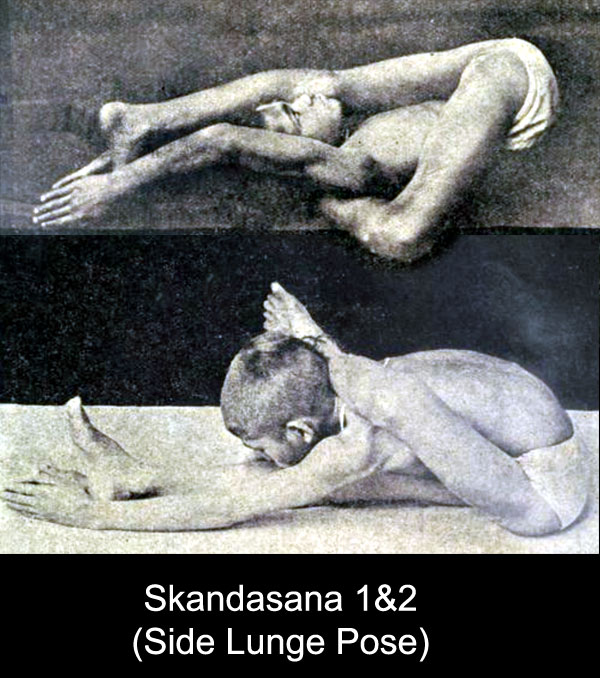
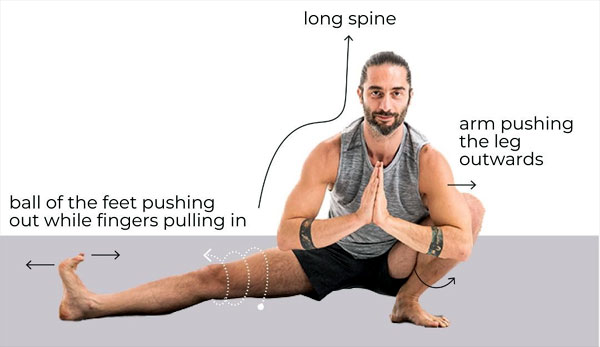
Benefits: Enhances closing the senses from the outside world to focus within (Pratyahara).
Durvasasana
(Standing Leg Behind Head Pose)
Method: (p140) Standing up, put one leg behind the head. Hands in Namaste mudra, do a half-forward bend. Extended leg must be kept straight. Gaze on the 3rd eye.
Variation: This can be done reclining.
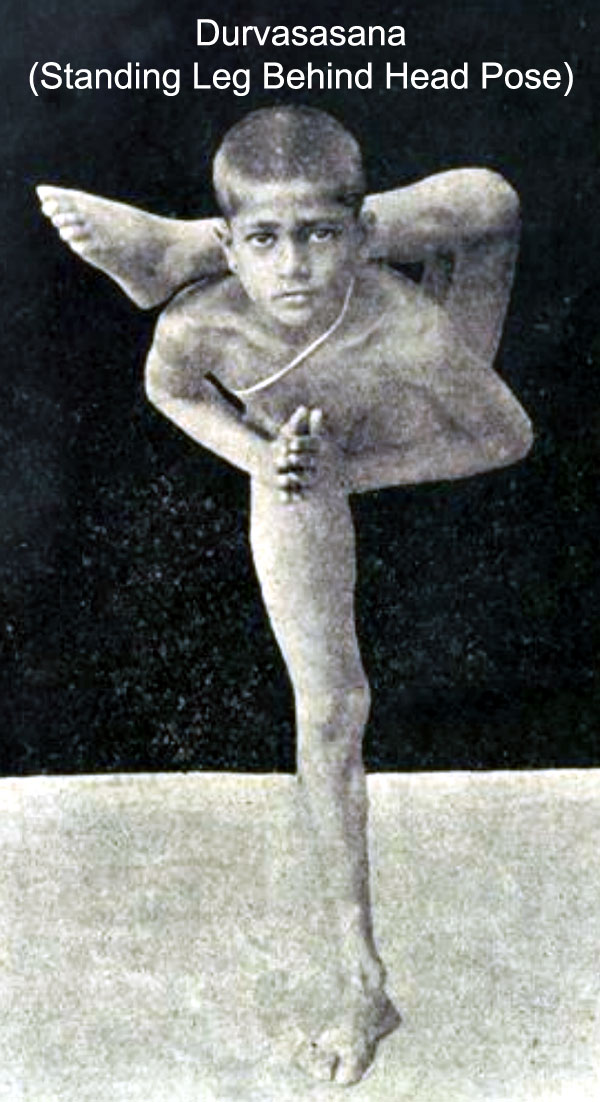
Benefits: Elephantiasis is cured, tremors in the head go away.
Richikasana
(Standing Foot Behind the Head Forward Bend)
Method: (p144) Standing, place one leg behind the head. Exhale and forward bend, touching both palms on the mat.
Variation:
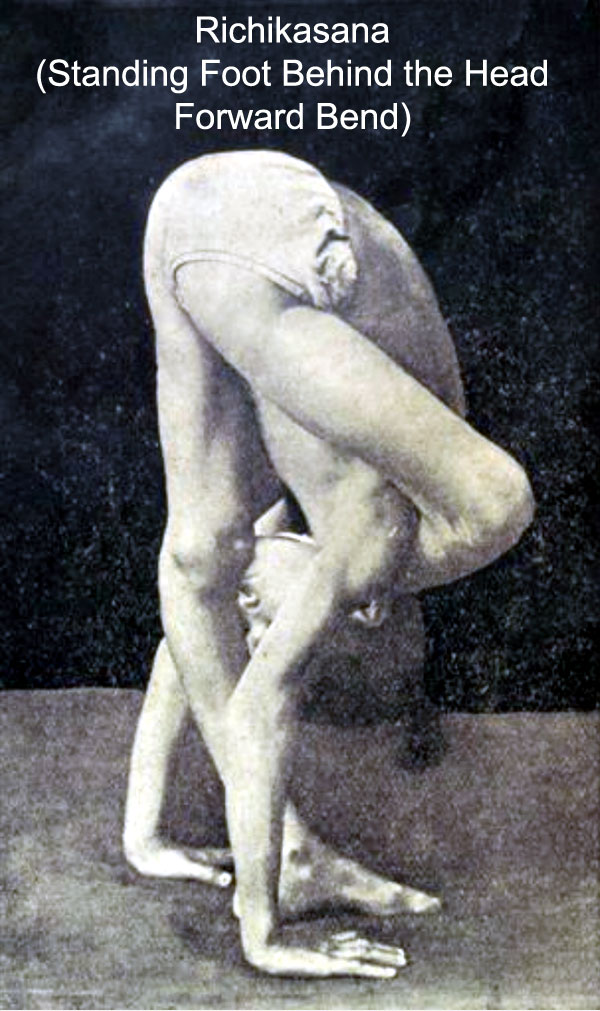
Benefits: This instills proper exhalation for pranayama.
Trivikramasana
(Standing Split Pose)
Method: (p144) On Tadasana, lift one leg until it is vertically inverted and push the soles down with both hands. Both legs should be straight. Do the other side.
Variation:
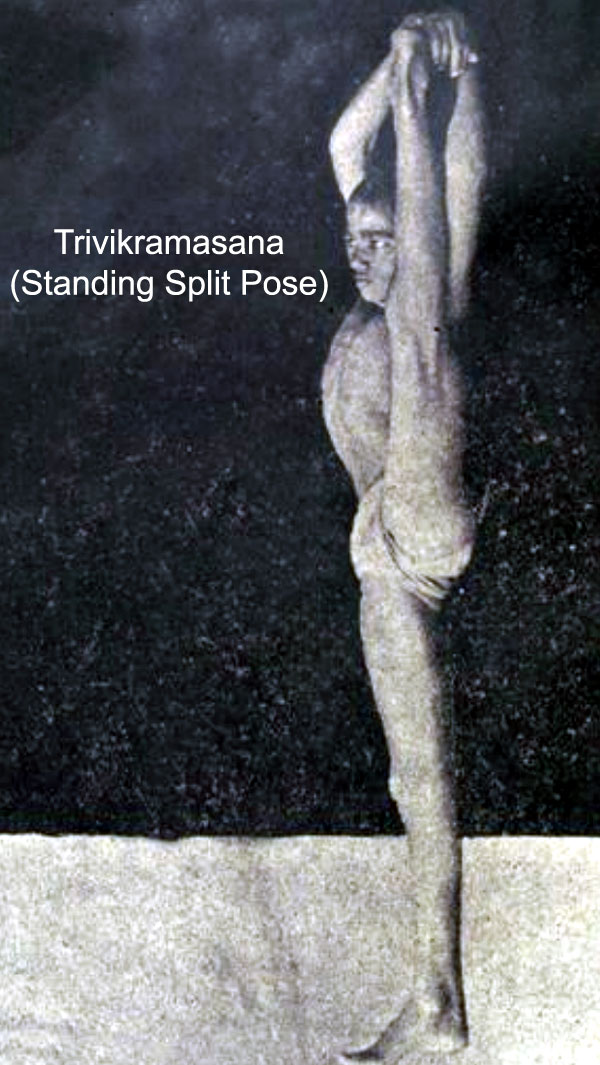
Benefits: Awakens Kundalini
Ganda Bherundasana
(Formidable Face Pose)
Method: (p144) From High plank, do Superman Pose with arms stretched sideways. Gradually do a backbend so the heels land beside the head touching the arms. Arms should now lock in place with each hand clasping the other's wrists. Fix the gaze on the 3rd eye. This is an extreme backbend With chin on the mat.
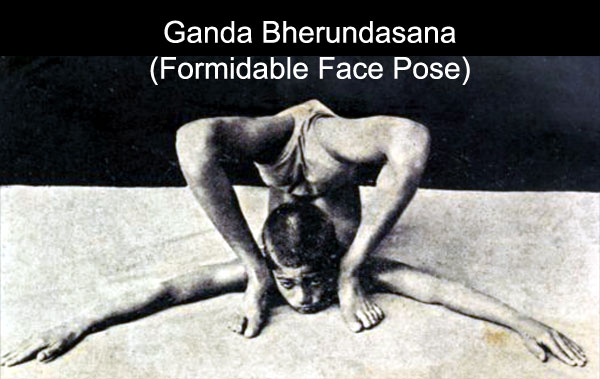
Benefits: Goiter problems and inflamation of the glands are cured. Vishuddhi and higher chakras are activated, leading to Samadhi.
Ending Thoughts
For the first few years of my yoga practice, I didn't know anything about theory. I just thought that yoga was Upward Dog and Downward Dog. Sure, it made me strong, resilient from disease, flexible, balanced and non-reactive. All that came from asana. But when I started reading the theories, texts, protocols, etc., my practice just went deeper and more intense. I now see asana as a very important part of yoga, but it's not the goal, but part of the long process to prime the spirit and the mind. In the end, what you want to achieve is mastery of the mind.
--- Gigit (TheLoneRider)
YOGA by Gigit ![]() |
Learn English
|
Learn English ![]() |
Travel like a Nomad
|
Travel like a Nomad ![]() |
Donation Bank
|
Donation Bank ![]()
Sources:
- Yoga Makaranda 1 by Tirumalai Krishnamacharya
- 8 Limbs of Yoga by Gaia
- Asana by Yogapedia
- Asana by Masterclass
Leave a comment?
Chiang Mai INFORMATION
Chiang Mai Map

Chiang Mai, Thailand
Chiang Mai FYI / Tips
- crop-burning season in Chiang Mai is between late Feb to early April. But laws change everytime. This year, 2019, there is a 61-day ban on burning so the farmers started burning early. When my plane was approaching Chiang Mai on Jan 24, 2019, there was already a thick blanket of smog covering the entire city (and beyond). But within the city itself, you won't feel it (but that doesn't mean the air is healthy). To monitor air conditions in real time, refer to site: Chiang Mai Air Pollution: Real-time Air Quality Index (AQI)
- hot season begins March and lasts until June
- wet season begins July and lasts until September
- best time to visit Chiang Mai is mid-September to mid-February - after the monsoon and before the burning
- you have to try Khao Soi, this is north Thailand's culinary staple
- the tourist area where most of the hotels, restaurants, ticket offices, tour operators are, is located in the Old City
- to exchange your dollars to Thai Baht, the Super Rich Money Exchange give the best rates. There are many branches scattered around Chiang Mai
- get a red cab (songthao) outside the train station for Baht 50 (instead of paying B100 if inside the train station) to Old City - if you haggle nicely enough...I did!
- shared red taxi (songthao) - B30 standard fare plying all over Old City
- for only B50/day, best to rent a bike to go around the Old City - it's a 2.5km2 with lots to discover
- FREE daily yoga classes from 9:00am to 10:15am at Nong Buak Hard Park (southwest corner of Old City). Resident and passing-through teachers take turns conducting yoga classes.
Blues/Jazz Bars in Chiang Mai
- North Gate Jazz Coop - at Chang Phueg Gate, great Tuesday jam session, Blues on Sundays at 11pm by the Chiang Mai Blues band
- Boy Blues Bar - at the Night Bazaar. Mondays at 9:30pm is open mic
- My Secret Cafe - near Wat Phra Singh. Tuesdays at 7:30pm for the changing front-act and 9:00pm for the Panic Band
- Taphae East - 88 Thapae Rd. (just north of Night Bazaar). Fridays at 9:30pm by Chiang Mai Blues Band
Chiang Mai Cost Index
- B60 Chiang beer
- B250 1 hour drop-in yoga session
- B200 one hour Thai body massage at WAYA Massage (highly recommended)
- B50 noodle soup with meat
- B50 coffee
- B40 pad thai
- B30/kilo wash-only laundry
- B50/kilo wash+iron laundry
- B100-150 dorm bed/night
- B250 fan room/night
- B30 internet cafe/hour
- B170-190 Movies Sat-Sun and public holidays
- B130-150 Movies weekdays
- B100 Movies Wednesdays (movie discount day)
- B750 1/2 day Thai cooking lessons
- B900-1000 1 full day Thai cooking lessons
- B400 Muay Thai boxing ticket
- B2500 starting room rate at the luxury hotel, Nawa Sheeva (highly recommended)
- B450 bus, Chiang Mai to Bangkok
- B160-180 bus, Chiang Mai to Pai
- B1250 bus, Chiang Mai to Luang Prabang
- B1650 slow boat, Chiang Mai to Luang Prabang
- B210 bus, Chiang Mai to Chiang Rai, 3-4 hours
- B360 Green VIP bus, Chiang Mai to Mae Sai (Thai border town for visa run to Tachileik, Myanmar)
- B50 bicycle rental, 24 hours
- B200 motorbike rental, 24 hours
- B273 #51 sleeping train from Bangkok to Chiang Mai
- B638 #7 a/c train from Bangkok to Chiang Mai
- B50 red taxi fare from point to point
- B100 red taxi fare from train terminal to city
- B2000 full day elephant sanctuary
- B750 Chiang Rai one-day tour
- B1500 mountain biking scenic ride
Chiang Mai Trains by Train36.com
- Chiang Mai trains for Bangkok - 2 day trains, 3 night trains, daily schedule
- Train 14 to Bangkok - departs 5pm daily, arrives BKK 6:15am, 1st class and 2nd class sleeping accomodation, Special Express
- Chiang Mai trains to other destinations -
Chiang Mai to Bangkok Trains
source: railway.co.th- Check Train Schedule & Fares
- Book Online - direct booking with State Railway of Thailand. Best to register first. If going to BKK from CNX, click "Northern Line".
note -- big difference between booking direct with the State Railway and booking with an online 3rd party agent. 12GO was charging B1330 for the same trip that only cost me B941 with the State Railway.
note -- Oct 2022, I took the #10 Train from CNX to BKK, upper berth, 2nd class, a/c, sleeper, B941. The train was clean, fast, comfortable and modern. If you have heavy luggage that will cost more money in flight checkin, I would suggest this train. Otherwise, the flight now is so much cheaper it doesn't even make sense to take the bus or train.
Bangkok to Chiang Mai by Train from Bang Sue Train Station
For more train info: Bangkok to Chiang Mai trains - departing from Hua Lamphong - MRT (Bangkok)
(I'm using Bang Sue as a starting point because I was closer to it, but you may be closer to the Hua Lamphong station)
- take the MRT train to Bang Sue Station. Take the #1 Exit to the north provincial trains
- Proceed to Counter 2. You will see an
information booth, a
train schedule chart and the
ticket counter. Choose the train and pay at the ticket counter.
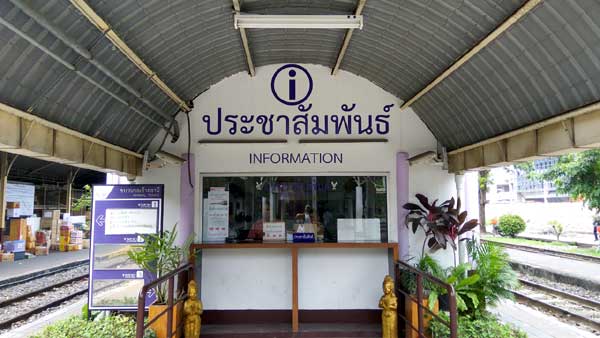
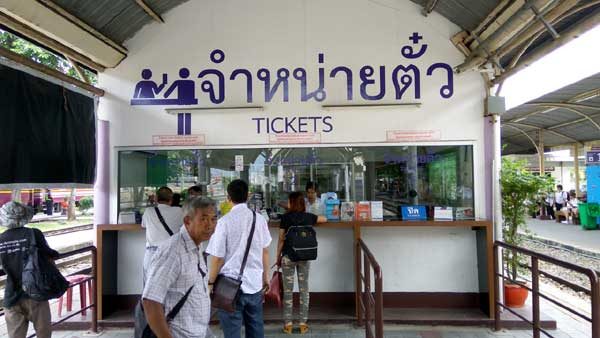
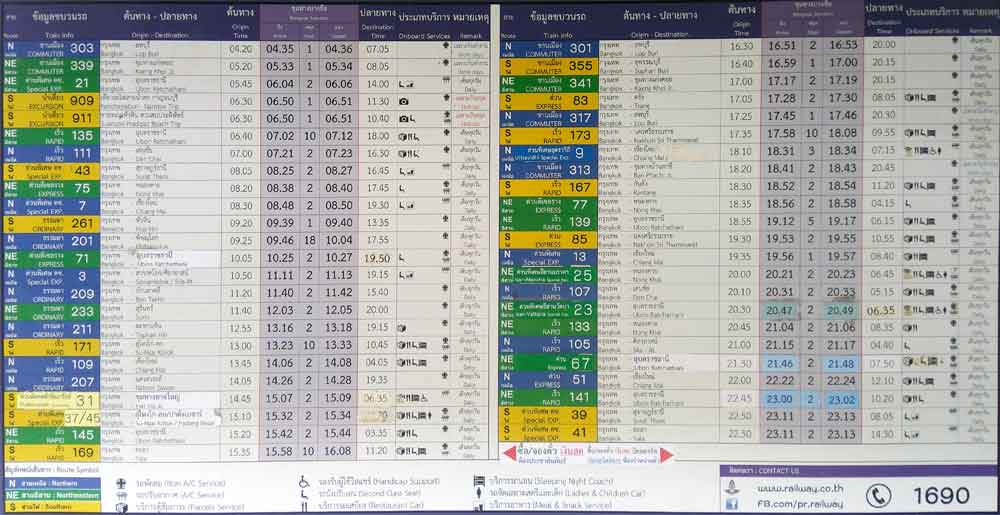
- daily train schedule:
- 8:48am - #7 Train, arrive Chiang Mai 7:30pm, not sleeper, B638
- 2:06pm - #109 Train, arrive Chiang Mai 4:05am, sleeper
- 6:31pm - #9 Premium Train, arrive Chiang Mai 7:15am, sleeper, B938 upper deck, B1038 lower deck
- 7:56pm - #13 Train, arrive Chiang Mai 8:40am, sleeper, B768 upper deck, B838 lower deck
- 10:22pm - #51 Train, arrive Chiang Mai 12:10pm, sleeper, 3rd class B270 (non sleeper), 2nd class B438, B728 upper deck, B798 lower deck
Loei to Chiang Mai by Bus
- From Loei town center, take a tuk-tuk ride to the bus station, B30. There is only one bus station.
- As of June 28, 2020 (still on Covid schedule), there are only 3 night trips: 8:30pm, 9:30pm and 12 midnight. 9 hours, B470.
- The bus makes the following stops at the following times from a 9pm Loei departure: Phu Ruea (9:50pm), Phitsanulok (12:40am), Uttradit (2:20am), Lampang (4:35am)
- Final bus stop is at the Red Bus Arcade, Chiang Mai, 9 hour-trip, arriving 6am (from 9pm Loei departure).
- Take a red songthaew to Old City, B50. They'll try to charge you B100, but they'll take B50 (just assure the driver you won't tell the other passengers).
Chiangmai Blogs by TheLoneRider
- Goodbye Chiang Mai Jan 24, 2019 - Oct 10, 2022
- Chiang Mai Peoplescape Oct 10, 2022
- Siamaya Chocolates Oct 2, 2022 [an error occurred while processing this directive]
- September Snapshots Sep 30, 2022
- Carrot Cake Sep 12, 2022
- Making Coconut Bread Sep 3, 2022
- August Snapshots Aug 31, 2022
- Yoga Nidra with Chunyah and Tom Aug 18, 2022
- Coconut Pancake Aug 11, 2022
- July Snapshots Jul 31, 2022
- Chiang Mai Peoplescape Jul 31, 2022
- Jason, Max and Elizabeth Pizza Nite Jul 28, 2022
- Yakiniku Dinner with Max and Jason Jul 25, 2022
- Icebath at Nawa Saraan Jul 6 - Oct 5, 2022
- June Snapshots Jun 30, 2022
- Tom, Chunyah and Simona Pizza Nite Jun 23, 2022
- Yoga Class Pizza Nite Jun 15, 2022
- Pranayama with Nicha Jun 14, 2022
- May Snapshots May 31, 2022
- Lover's Quarrel May 26, 2022
- Getting Lost on a Hike May 25, 2022
- Biohacker Meetup at 'Living with The Spirit' May 22, 2022
- Music and Magic at Paapu House May 5, 2022
- Breathwork + Icebath @ Alt_Chiangmai II Apr 20, 2022
- April Chronicles 2022 Apr 30, 2022
- Tombstone Epitaph Apr 29, 2022
- Kayaking along the Ping River with the BioHackers Apr 24, 2022 [an error occurred while processing this directive]
- Pizza Nite with Jerry, Paolo and Abby Apr 9, 2022
- Tom Maher's Muay Thai Fight Apr 8, 2022
- Breathwork + Icebath @ Alt_Chiangmai Apr 6, 2022
- Yoga with Leo Apr 5, 2022
- March Chronicles 2022 Mar 31, 2022
- Street Photo Mar 31, 2022
- Peoplescape Mar 31, 2022
- Chiang Mai's Recovering Music Scene Mar 31, 2022
- Street Photo Mar 31, 2022
- Yoga and Fitness Mar 26, 2022
- Friday Bitcoin Meetups Mar 18, 2022
- Pizza Nite with Aida and Sophie Mar 14, 2022
- Pizza Nite with Kevin, Jamie and Kris Mar 10, 2022
- In Search of Genetic Immortality Mar 5, 2022
- February Chronicles 2022 Feb 28, 2022
- Palm-Feeding Wild Birds Feb 26, 2022
- Cuckoo Feb 16, 2022
- Tell John Feb 16, 2022
- Pizza Nite with Kris, Simona and Mary Feb 15, 2022
- Pizza Nite with the Chiang Mai Boyz Feb 6, 2022
- Welcoming the New Year Jan 31, 2022
- January Snapshots Jan 31, 2022
- ABS Fitness Challenge Jan 16 - Apr 16, 2022
- Pumpkin Tahini Recipe Jan 3, 2022
- 2021: A Year in Review Dec 31, 2021
- Pizza Nite with Simona and Lisa Dec 28, 2021
- Tahini Salad Dressing Dec 27, 2021
- Baba Ganoush Recipe Dec 23, 2021
- 7 Universal Laws Dec 20, 2021
- Sacred Circuitry Dec 18, 2021
- Cave-Living in a Boutique Hotel in Chiang Mai Dec 14, 2021
- Tummo Yoga + Wim Hof Breathing + Full-Body Muscle Contraction Dec 13, 2021
- Monk Chat Dec 10, 2021
- Making Tahini and Hummus Dec 8, 2021
- Watering the Plants Hands-Free Dec 2, 2021
- Vietnamese Phin Coffee Filter Dec 2, 2021
- Tummo Yoga Dec 1, 2021
- The Bliss of Inner Fire: Book Summary/Review Dec 1, 2021
- The Bliss of Inner Fire: Heart Practice of the Six Yogas of Naropa Dec 1, 2021
- 'Must Experience' Cafés of Chiang Mai Nov 30, 2021
- British Hobnob Cookies Nov 22, 2021
- New York Cheese Cake Nov 22, 2021
- Dham's Poetry Nov 14, 2021
- Pizza Nite with Simona and Nat Nov 11, 2021
- Stepping Forward / Reaching Out Oct 31, 2021
- Cancel Culture Attack Oct 31, 2021
- Mantra Primer Oct 29, 2021
- Spinal Mobility Oct 7, 2021
- Swedish Cinnamon Rolls [Kanelbullar] Oct 4, 2021
- Just Bring 2 Chinese Oct 3, 2021
- Sep Snapshots Sep 31, 2021
- One-Leg Yoga Asana Sequences Sep 30, 2021
- Pizza Nite with Nut, Monika and Yuki Sep 27, 2021
- 23-Minute Ice Bath Sep 27, 2021
- Pizza Nite with Nut, Simona and Malee Sep 23, 2021
- Yoga Nidra (yogic sleep) Sep 23, 2021
- Making Cornbread Sep 15, 2021
- Kombucha: 2nd Batch Sep 11, 2021
- Making German Stollen Bread Sep 9, 2021
- Pizza Nite with Jackson, Goi and Paapu Sep 6, 2021
- Chiang Mai Peoplescape Aug 31, 2021
- Making Homemade Kombucha Aug 30, 2021
- Wrong Question to Ask This Crowd Aug 29, 2021
- Pizza Nite with Tom, Chunyah and Goi Aug 20, 2021
- Pizza Nite with Moms and Kids Aug 15, 2021
- Bahya Kumbhaka (breath-hold on the exhale) Aug 14, 2021
- Everybody's Only Friend Aug 13, 2021
- Vanillekipferl (German Vanilla Crescent Cookies) Aug 11, 2021
- Fighting Infection through Yoga Aug 3, 2021
- Too Close for Friendship Aug 2, 2021
- Manifesting: Epicurus' Pursuit Jul 31, 2021
- Homemade Rum Raisin Ice Cream Jul 30, 2021
- Ice Bath at Nawa Saraan Healing Space Jul 25, 2021
- Pizza Nite + Slack Line + Hammock Jul 23, 2021
- Yin-Yoga & Hypnosis with Christine Thiel Jul 20, 2021
- Pizza Nite with James and Nat Jul 19, 2021
- Antara Kumbhaka on Nadi Shodan Pranayama: Yogic Breath-Hold on the Inhale Jul 17, 2021
- Moving and Cashing-Out Bitcoin Jun 2 - Jul 11, 2021
- 'The Bow' Yoga Jul 7, 2021
- Yoga Classes with Calum Mar 27 - Jul 4, 2021
- Hike to Wat Pa Thammachat Waterfall Jul 2, 2021
- Pizza Brunch with the Yogis July 1, 2021
- Continuing Friendships in Chiang Mai Jun 30, 2021
- On the Brink of Hunger, the ENABLERS Come to Light Jun 21, 2021
- Hatha Vinyasa Yoga with Katharine Day Jun 17, 2021
- Pranayama Basics II Jun 16, 2021
- 36-Hour Love Life Jun 11, 2021
- Pranayama Basics I Jun 9, 2021
- Biohackers Meetup in Chiang Mai Jun 6, 2021
- Learning How to Breathe Jun 2, 2021
- Not the Usual Day-to-Day Life May 31, 2021
- Morphing Peoplescape of Chiang Mai May 31, 2021
- Breathwork & Ice Bath with Jason Ryer of Zen Strength May 23, 2021
- It's Raining Bell Peppers May 7, 2021
- Yoga Classes with Nana Apr 20, 2021
- You Want to be Wonder Woman? Apr 8, 2021
- Kunjal Kriya / Vamana Dhauti (induced vomiting) Apr 1, 2021
- Coffeemates, Breadmates and Yogamates in Chiang Mai Jan-Mar 2021
- Varisara Dhauti (cleansing of the entire digestive tract) Mar 26, 2021
- Spiritual Backpacker Interview by Napasorn 'Cherry' Suvarnapradip Mar 23, 2021
- Private One-on-One Yoga Classes with Doriana Feb 17 - Mar 14, 2021
- Transformational Life Events Mar 13, 2021
- Guess Who's Coming to Bread Day? Mar 1, 2021
- Mula Shodhana (anal cleansing) Feb 27, 2021
- Are You My Queen? Feb 25, 2021
- Breaking the 5-Minute Breath-hold Barrier Feb 25, 2021
- Kirtan with Chiang Mai's Khun Thai Seekers Feb 7, 2021
- Breaking the 4-minute Breath-hold Feb 7, 2021
- Pranayama Primer Feb 2, 2021
- Heartbreak in every Song Jan 24, 2021
- The Silent Killer is Baaack! Jan 12, 2021
- Learning the Thai Language Jan 9, 2021
- 2020: A Year in Review Dec 31, 2020
- Reversing/Slowing Down the Aging Process Dec 30, 2020
- Hike to Huay Keaw Waterfall Dec 20, 2020
- Yoga Mat Dec 19, 2020
- Hiking to Wat Pha Lat along the Monk's Trail Dec 19, 2020
- Am I Psycho? Dec 9, 2020
- Muffin Man Dec 8, 2020
- Polyamory Dec 4, 2020
- The Wim Hof Ice Bath Dec 3, 2020
- RSVP Nov 25, 2020
- High Intensity Interval Yoga (Yoga + HIIT) Nov 14, 2020
- Cleansing the Nadis (Energy Pathway) Nov 13, 2020
- Yoga for a 360-degree Core Nov 6, 2020
- Edward Witten: 'the smartest living physicist' Nov 4, 2020
- Srinivasa Ramanujan: Mathematician of the Divine Oct 27, 2020
- Bashar as Channeled by Darryl Anka Oct 26, 2020
- Vinyasa Krama and Ashtanga Yoga with Aida Yoga Oct 18, 2020
- Deepak Chopra: author, lecturer, healer Oct 12, 2020
- Facebook Friends Oct 1, 2020
- Chiang Mai Peoplescape Aug-Sep 2020 Sep 30, 2020
- Siddhis (yogic super powers) Sep 30, 2020
- Learning the Import/Export Trade Sep 4, 2020
- Music and Magic at Justin's Birthday Bash Sep 3, 2020
- Biggest Stone in his Shoe Sep 1, 2020
- Abandoned Aug 25, 2020
- Intelligent Romantic Break-up Aug 25, 2020
- Dad-Zoned Aug 18, 2020
- Public Display of Affection Aug 9, 2020
- Gabriella's Birthday Bash at Mothership Resort Aug 8-9, 2020
- Shifting Peoplescape of Chiang Mai July 31, 2020
- Yoga Class for Strength and Muscle Jul 30, 2020
- Yoga Class for Optimum Digestion July 29, 2020
- Yoga Class for Healthy Eyes Jul 27, 2020
- Hippie Night at Nawa Saraan Healing Space July 24, 2020
- The Podcast Series: Alan "Heart Math" Strydom Jul 17, 2020
- Prana Vayu Adhitthana Yoga Class July 11-12, 2020
- Coming Back to Chiang Mai Jun 29, 2020
- Goodbye Chiang Mai Jan 23, 2020
- Prasnopanishad: Understanding Prana Jan 17, 2020
- Hiking the Monk's Trail Jan 15, 2020
- Chaturanga Jan 10, 2020
- You Spooned Me Jan 3, 2020
- 2019: A Year in Review Dec 31, 2019
- Friends, Coffeemates and Breadmates (Dec 2019) Dec 31, 2019
- Visiting Mae Sot Dec 27-30, 2019
- Let's Make it About You - an Epiphany Dec 17, 2019
- Shut-Up! Dec 7, 2019
- Roasted Red Bell Pepper Puree Dec 3, 2019
- Coffeemates and Breadmates (Nov 2019) Nov 30, 2019
- Bhujangini Mudra Nov 25, 2019
- Mathangini Mudra Nov 24, 2019
- Kaka Mudra Nov 23, 2019
- Pasini Mudra Nov 20, 2019
- Aswini Mudra Nov 18, 2019
- Sambhavi Mudra Nov 16, 2019
- Manduka Mudra Nov 15, 2019
- Tataka Mudra Nov 14, 2019
- Sakti Calana Mudra Nov 10, 2019
- Vajroli Mudra Nov 9, 2019
- Coffeemates and Breadmates (Oct 2019) Oct to Nov 5, 2019
- Yoni Mudra Nov 1, 2019
- Viparita Karani Mudra Oct 31, 2019
- Khecari Mudra Oct 30, 2019
- Mahadeva Mudra Oct 28, 2019
- Sacred Cacao - Chakra Dance Journey Oct 26, 2019
- Partner Healing with Natascha Oct 24, 2019
- Maha Bandha Mudra Oct 24, 2019
- Point-Of-Failure Birthday Workout Oct 22, 2019
- Mula Bandha Mudra Oct 21, 2019
- Hugfest at Thapae Gate, Chiang Mai Oct 19, 2019
- Anushasan Mudra Oct 18, 2019
- Ling Mudra Oct 17, 2019
- Jalandhara Bandha Mudra Oct 15, 2019
- Learning Thai with Cee Oct 13, 2019
- Uddiyana Bandha Mudra Oct 10, 2019
- Nabho Mudra Oct 9, 2019
- Maha Mudra Oct 7, 2019
- 20 Essential Mudras by T. Krishnamacharya Oct. 6, 2019
- Mindfulness Gong Bath by Vee (Veerayuth Pongsiri) Oct 3, 2019
- Cuddle Party by Abundant Love CM Oct 1, 2019
- Vayu Mudra Oct 1, 2019
- Visa-Run to Tachileik, Myanmar Sep 28, 2019
- Sankalpa Mudra Sep 27, 2019
- Surya Pradarshini Mudra Sep 26, 2019
- Eye-Gazing at Heart Space Sep 20, 2019
- Prana Vayu (Pranic Wind) Sep 20, 2019
- 2-Week Yoga Challenge by Agnese Erba Sep 17, 2019
- The Mudra Project Sep 13, 2019
- Sunday Vinyasa Flow with Marina Forster Sep 8, 2019
- Shamanic Breathwork by Rachel Constantino Sep 4, 2019
- The Conscious Peoplescape of Chiang Mai Aug 31, 2019
- Of Winos and Yogis Aug 26, 2019
- The 9 Jhanas of Buddha Aug 22, 2019
- Wicked Game: Anger and Pain August 19, 2019
- Full Moon Ceremony at Heart Space Aug 15, 2019
- Yin Yoga - Water Element by Martina Barabas Aug 15, 2019
- Hatha Mix Yoga with Christin Aug 13, 2019
- Boy Blues Bar Rocks Chiang Mai Aug 5, 2019
- Back to my Beloved Chiang Mai Aug 1, 2019
- Kaleidoscope of Chiang Mai's Peoplescape July 27, 2019
- Secret Sunrise: Nelson Mandela International Day July 17, 2019
- Farewell Picnic with Alan and Nicola July 15, 2019
- Secret Sunrise: Water July 3, 2019
- Hotel Review: Arun Suite June 27, 2019
- Bruce Lipton: Epigentics to Transcend Genes June 24, 2019
- Optimizing Life thru Heart Math May 8, 15 and 22, 2019
- Connective Cacao and Sound Journey June 12, 2019
- Chiangmai BLUES June 6, 2019
- Hatha Slow Flow with Neil Jefferson June 3, 2019
- Meditating with One Million Meditators Movement June 1, 2019
- Vinyasa Happy Flow Series by Vaida May 31, 2019
- Muay Thai at the Chiang Mai Boxing Stadium May 30, 2019
- Yoga Flow Through the 7 Chakras by Sabrina Pilz May 30, 2019
- The Outsiders (people you need to push out of your sacred circle) May 31, 2019
- Fascinating Peoplescape of Chiang Mai May 22, 2019
- World Meditation Day at Heart Space May 21, 2019
- Abs Yoga by Gigit May 12, 2019
- Kundalini and Vinyasa Yoga with Nicola Symons May 10, 2019
- Secret Sunrise Interactive Dance May 9, 2019
- Tok Sen Massage from Ying May 8, 2019
- Bruschetta: Nawa Saraan Style Apr 22, 2019
- Thai Cooking at Pra Nang Thai Cookery School Apr 20, 2019
- Bonding with the Elephants in Chiang Mai Apr 11, 2019
- Ziplining in Chiang Mai with Eagle Track Zipline Apr 10, 2019
- Getting Thai Massage from Chiang Mai's Best (Lar Thanakrit Khamtanong) Mar 21, 2019
- Being the Soul of Nawa Saraan Hotel Mar 18, 2019
- Peoplescape of Chiang Mai Jan 24 - Mar 13, 2019
- Curing Cancer with Yoga? Feb 21, 2019
- International Training Massage School (ITM): Level 1 Feb 11-15, 2019
- Sandesch Album Launch by Christoph Joerg Feb 13, 2019
- Meditation in a Sensory Deprivation Tank at Float Chiang Mai Jan 29, 2019
- Reiki Share at the Mastermind Brain Spa Jan 26, 2019
- Resuming Life in Chiang Mai Jan 24, 2019
- 4 Days in Chiang Mai at Nawa Saraan Hotel Jan 2-6, 2019
- Mike Chong Aug 8, 2018
- An Intimate Conversation with my Universe in Chiang Mai Aug 8, 2018
- Kneaded and Pampered at Zira Spa Aug 4, 2018
- Savoring a Baht 3,500 Birds Nest Soup at Natural Bird Nest by Burapa Aug 3, 2018
- Yoga Exploration at The Yoga Tree with Gernot Aug 1, 2018
- Laughter Yoga with Saffiya Arnous July 31, 2018
- Yoga with Adam at Hidden House Yoga, Chiang Mai July 29, 2018
- 2 Weeks in Chiang Mai July 25 - Aug 7, 2018
- A First Timer in Chiang Mai Apr 9-23, 2016
- Chiang Mai's Amazing Peoplescape Apr 9-23, 2016
- Dance Mandala in Chiang Mai at The Yoga Tree Apr 19, 2016
- Songkran Waterfight Festival in Chiang Mai Apr 13-15, 2016
- Border Crossing from Siem Reap (Cambodia) to Bangkok (Thailand) to Chiang Mai April 9-10, 2016
Travel Tips for Thailand
How to Get a 60-Day Thai Tourist Visa and then Extend by another 30 Days
This process is BEFORE Covid 19. Not sure what it is now.
- Bring the following to the Thai embassy:
a) proof of money (bank statement will suffice)
b) flight booking to Thailand
c) onward flight back to your country from Thailand
d) filled-in tourist visa form
e) 2 passport pictures
f) hotel booking in Thailand (they didn't ask me for this but better be safe)
g) passport with at least 6 months validity - After handing over all the documents, they will ask you to come pick your passport with the visa the following day from 4 to 5pm. That's it!
- NOTE: after 2 successful attempts, I was already questioned the 3rd time.
60-Day Thai Tourist Visa
NOTE: There is no need to go back to your country to get the Thai tourist visa. Any major city with a Thai Embassy will do. Apparently there is also no need to have an invitation from a Thai establishment to justify the visa.
- bring the following to the Immigration Office:
a) passport (make sure your Tourist Visa hasn't expired yet)
b) Baht 1900
c) photocopy of your passport + visa duration date stamp + TM6 card (white immigration card) and sign all the copies
d) completed TM7 visa extension form (available at the Immigration Office)
e) one 4cmx6cm passport picture - submit the above to the Front Desk. They will give you a stub with your number on it. Take a seat and wait for your number to be called
- when your number is called, your picture will be taken. Then go back to your seat. They will call you again.
- when they call you again, they'll give you your passport with your extended visa. That's it!
- when there are no lines, the whole process can take only 10 minutes
30-Day Extension
NOTE: When your 60-day visa is close to expiry and you want to extend your stay. No need to leave Thailand.
Book Train Tickets in Thailand
Book Train Tickets in Thailand Online by Train36.com
General Travel Tips
- arrive early - in case there is a snag (visa snag, documentation snag, transport ticket snag, etc.), you will have ample time to troubleshoot the problem if you arrive early (to the airport, to the bus terminal, etc.)
- put detailed itinerary on the Calendar apps of your smart-phone according to timelines - this is where you do all your thinking and planning. Once written down, you don't have to think anymore while you are on the journey...you just follow the steps. This frees your mind for something else that might happen while you are already en route
- avoiding scams - as a general rule, I ignore the touts or anyone I don't know who call out to me. The calling comes in many forms - "Hi! Where are you from?", "Excuse me! Excuse me!", "Where are you going?". I don't look them in the eye and I remain non-verbal with them. If you reply to them, you just gave them an 'in' to hound you. In order not to look rude, I smile and wave the 'not interested' hand to them, without looking at them.
- power bank - hand-carry your power bank. Do not check it in. You can be called in when you are already inside the plane to go all the way to the loading dock so you can personally remove the power bank...and chances are, you'll have to surrender it to them. And you might delay the plane departure!
Currency Converter
»» back to Yoga
»» back to Homepage
ARCHIVE 2025:
JAN |
FEB |
MAR
1970 |
1973 |
1975 |
1976 |
1977 |
1979 |
1981 |
1996 |
2000 |
2001 |
2002 |
2003 |
2004 |
2005 |
2006 |
2007 |
2008 |
2009 |
2010 |
2011 |
2012 |
2013 |
2014 |
2015 |
2016 |
2017 |
2018 |
2019 |
2020 |
2021 |
2022 |
2023 |
2024 |
2025 |
ALL BLOGS
